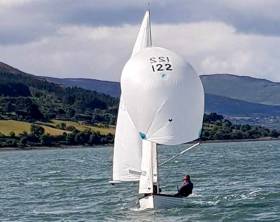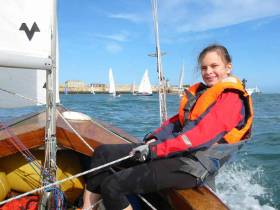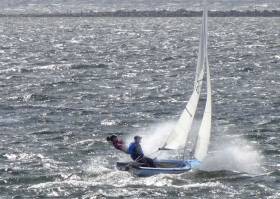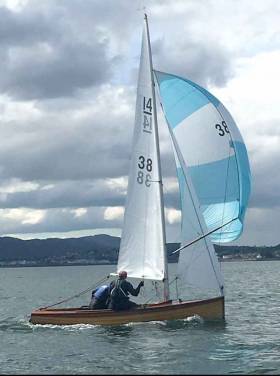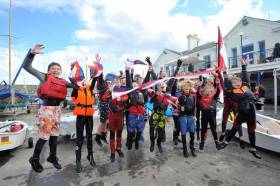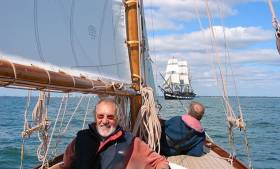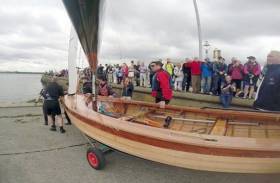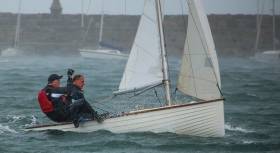Displaying items by tag: IDRA 14
IDRA 14s Reformat Dinghy Class Rules to Comply with World Sailing's Equipment Rules of Sailing
Virtual meetings, which are part and parcel of life now, are nothing new to the team of IDRA 14 dinghy sailors who have just completed the task of formatting the IDRA 14 Class rules to comply with those of World Sailing. The IDRA 14 Class Association Rules 2020 document was launched online recently with all the committee work leading up to the launch, being achieved through online meetings.
Starting as far back as 2018, the team of three on the IDRA 14 Class Rules committee met virtually, on a fortnightly basis, via Skype and used Google Docs to complete the intricate work of transposing the 1983 IDRA 14 Class Rules from various class documents and drawings to the latest World Sailing template. Meeting remotely meant that they could get on with the job without having to spend time organising a venue and travelling.
Having a set of Class Rules in line with the World Sailing Class Rules template 2009 (updated 2012) is very important for any competitive class. It means the Class Rules can now be read in conjunction with World Sailing's Equipment Rules of Sailing for 2017-2020, known as the ERS. The Equipment Rules of Sailing (ERS) govern the equipment used in the sport. They are revised and published every four years by World Sailing. The ERS provides sailors, measurers, boatbuilders and sailmakers alike with standard definitions and methods of measurements that when used in Class Rules avoid misinterpretation and potential conflict.
 The IDRA 14 dinghy class prepare to start a race - 2021 sees the historic class celebrate its 75th anniversary
The IDRA 14 dinghy class prepare to start a race - 2021 sees the historic class celebrate its 75th anniversary
The IDRA 14 Dinghy Class will be celebrating its 75th Anniversary next year. The class has kept its appeal as an exciting two crew dinghy with trapeze and spinnaker and a fibreglass version of the boat being included in the class rules over the years.
This family-friendly class is known for competitive and affordable racing, with a great team spirit throughout the class. The class members were very much on board with the move to reformat the rules and held two Information and Question & Answer sessions at the start of the process. These two meetings were held in Clontarf and Dun Laoghaire, as IDRA 14 racing takes place in Sutton Dinghy Club, Clontarf Yacht & Boat Club and in Dublin Bay Sailing Club, with most of the Dun Laoghaire boats raced from the Dun Laoghaire Motor Yacht Club.
At the information sessions, it was made clear that the aim was not to change the class rules but to make sure that they were compliant with the latest version of the World Sailing ERS and to sort out any anomalies.
When the IDRA Class Rules Committee got started on their Skype meetings, it soon emerged that each of the three IDRA 14 sailors had their own area of specialisation.
Alan Henry, an engineer and numerous times class national champion, had consistently innovated and pushed the boundaries within the class. Donal Heney's expertise was boat building as he played a central role in the building of IDRA 14 166, in 2016 (the first wooden IDRA to be built in over thirty years). Julie Ascoop, a civil engineer and also former class national champion, specialised in standards and specifications. "Each brought a different experience to the job which made for a very good team", Julie commented.
 (Above and below) Computer renders of the traditional clinker-built IDRA 14 dinghy hull
(Above and below) Computer renders of the traditional clinker-built IDRA 14 dinghy hull

Each team member took on homework to be completed before the next online meeting. This entailed tasks such as measuring a part of the boat, taking photos or checking approaches taken in the rules of other classes, such as the Fireballs or 470s. Using Google Docs during their meetings meant that when a committee member was inputting text in the new document, the others could work on the same document at the same time thus addressing the issue of revision control.
The task involved sorting out quite a few anomalies, one of which first appeared to be quite dramatic: the current masts were 8cm longer than the measurement in the 1983 Class Rules. "That had us spooked", Alan said, but when the team discussed it with Class historian, Ian Sargent and his brother Charles, the IDRA Class Commodore, it was quickly established that the mast measurement had been changed at a past AGM and, after some searching, the relevant rule amendment document was produced. If someone had used the old rules when purchasing a new mast they would have found themselves at a serious disadvantage, Julie explained. This highlighted the issue of maintaining the current set of rules and avoiding spurious versions. A process of updating and maintaining the class rules has now been developed, and the current version is now held online so that it can be easily accessed.
Donal explained that another challenge was that the original offset table, a set of measurements defining the IDRA 14 hull shape, had gone missing.
The IDRA 14 Class was very fortunate to get naval architect Ruairi Grimes involved who produced a digitised version of the original IDRA 14 drawings and set up a 3D model of the IDRA 14 hull from which the offset table could be derived.
Ensuring that these new drawings were a true representation of the original IDRA 14 was crucial so it was decided to compare the original drawings and the digitised version. To this end, the digital version was printed at the exact same scale as the original Class Rules drawings. The newly generated drawing was placed over the original and with the aid of a lightbox, it was established that there was only one flaw in the computer-generated drawings, which was duly corrected.
 Voting at the IDRA 14 class egm, pre-COVID
Voting at the IDRA 14 class egm, pre-COVID
The IDRA Class Rules Committee managed to complete the vast majority of the work through virtual meetings and was extremely lucky that the information meetings, the meeting with the class measurers and the EGM all took place before March 2020. By the time the country was in the grip of Covid restrictions, all that remained to be done was just to implement the decisions made at the Class Rules EGM.
As well as passing the IDRA Association Class Rules 2020 at the January EGM, the class members accepted 18 of the 22 proposals which the Class Rules Committee had come up with arising from the anomalies they had identified during their class rules work.
Julie Ascoop sees a lot of benefit for the class in having the IDRA Class Rules compliant with the World Sailing Class Rules. "The main thing is that it's now in the right format and uses the correct definitions", she explains. "A sailmaker, for example, will know the relevant ERS numbers for each particular measurement of the sail and will have all the information to hand in a format that's familiar", Julie said. It will also make it much easier to update the class rules at any point, something which might be required if there are any future developments in technology or racing equipment.
The IDRA Class Association Rules 2020 can be downloaded below.
Revill & Henry back to back IDRA 14 Champions on Carlingford Lough
After the near gale force racing conditions and white-knuckle sailing experience of 2017, this year’s IDRA 14 Nationals held at Carlingford Sailing Club 9th–11th August proved a more nuanced and tactical racing experience for the 15 boats that competed over the 3 days of the Championship.
The Club has views of the Lough and Cooley and Mourne mountains nearby and the weather over the three days racing was generally good, which made the event for the competitors and family and friends that accompany these events very enjoyable. Carlingford Lough is known for its unusual wind patterns, particularly where the wind comes from the west rolling down the mountains, and so it proved on the first day’s racing where the wind was light and with significant holes and changeable in direction. Despite this, Race Officer Ian Sargent managed to complete one race after moving the race area northwards which was won by 14/134 “Dubious” of Sutton Dinghy Club, last year’s winner - but this year helmed by Simon Revill with Alan Henry as crew. New to the IDRA fleet, Ryan Cairns and Ian Byrne (Clontarf Yacht & Boat Club) 14/128 “Dr. J.P. Frog” were second.
Day 2 of the Championship brought more stable northerly winds coming down the Lough, and 3 back-to-back races were held close to the clubhouse. Newly-partnered Catherine Martin and Brian Murphy in 14/122 “Diane” of Dun Laoghaire Motor Yacht Club raced superbly, keeping tight to the shore to avoid the strong tide and won two of the three races, while Revill and Henry kept in the chase achieving three-second places. Alan Carr and Dana Kilroy in 14/38 “Starfish” (Sutton Dinghy Club), always in the mix at National Championships, lay in third position at the end of the day.
"The Championship proved a great result for Sutton Dinghy Club taking first and third places"
Day 3 brought more stable, sea-like conditions with southerly winds blowing Force 4, gusting 5 which brought some challenging moments with Revill flying full spinnaker capsizing in Race 5, letting the fleet blast through. Unfortunately, Cairns suffered gear failure and retired. Race 6 ended with Revill taking the final win of the series and the Championship, with Martin and Murphy taking second only two points behind, with Carr and Kilroy third.
The Championship proved a great result for Sutton Dinghy Club taking first and third places, but the Dun Laoghaire Motor Yacht Club squad were delighted with three of their members being in the top 5 including Catherine Martin and Brian Murphy taking second (the highest result in 9 years for the Club!), Pierre Long and John Parker fourth and Julie Ascoop and Sinead Mangan fifth - no doubt a reflection of the intensive racing these sailors are enjoying in the DBSC series at Dun Laoghaire. The event ended with an evening dinner and prizegiving at the clubhouse, where Simon Revill and Alan Henry were awarded their trophy and announced that after 9 years racing together they would be parting ways.
IDRA14’s, Vagos and Finns from the DBSC, Fireflies from the universities, Magno’s and Pico’s from the INSS, and Waszp’s toing and froing from the National YC – Dun Laoghaire harbour on Saturday represented all that is good and healthy about dinghy sailing in Dublin Bay, as the DBSC dinghy fleets gathered for the final Saturday races of the season.
A light breeze and glorious warm sunshine greeted the sailors as they made their way to the race area. A full turnout of eight boats in the IDRA14 fleet continued a season long trend – a trend which has seen a 67% average turnout for Saturday racing.
Racing has been both competitive and good natured, with tight competition on the water matched by a strong spirit of friendship and cooperation off the water. Saturday racing within the harbour walls has provided great opportunities to introduce new members both to the class and to racing in Dublin Bay. This was also evident on Saturday when Charles Sargent brought his granddaughter Eimear (pictured above) out for her first active racing in an IDRA14.
On the racing itself Frank Hamilton and Marjo Moonen in 14/140 proved to be an unstoppable force as they recorded three straight wins (results are here) to put them in pole position for the Saturday title. In the PY fleet, Richard Tate made a successful return in his Finn to also record three straight wins.
Brian Murphy of the IDRA14 fleet in Dun Laoghaire told Afloat.ie 'we would like to extend our thanks to DBSC, the committee boat personnel, and the patrol crew personnel for what has been a very successful 2017, and we look forward to more competitive Saturday racing with an ever growing fleet in 2018'
IDRA 14 Pair Henry & Revill Make It 'Three in a Row'
Alan Henry & Simon Revill made it “three in a row” in the picturesque waters of Galway Bay on 17/19th of August, winning the IDRA 14 National Championship for their third consecutive year.
18 boats gathered in GBSC on the Wednesday with a poor forecast for both wind & rain. Since we were last here six years ago, the Club location has been designated as part of the new western seaboard tourist trail – the “Wild Atlantic Way”…. it was to live up to its title during our visit!!
Wednesday’s practice race had no takers and was cancelled as we all ansiously awaited the outcome of the well-forecasted gales due to hit the west coast. The Club have an excellent automatic continuous print out of the weather / wind / barometric pressure etc. from the nearby Marine Institute, which provided excellent live information.
Thursday arrived with wind of 18 kts with gusts of 23 kts, on a moderate sea. It was decided to go for the two scheduled races, so 17 boats took to the water … but not all made it to the starting line! Race 1 proved to be exciting as the weather took its toll, with thrills and spills galore. Alan Henry & Simon Revill in 14/134 won the race, beating Alan Carr & Diarmuid Brodie 14/38 into second place, followed by Charles Sargent & grandchild Caoimhe Fleming 14/126 in third place. Pierre Long & John Parker 14/161 came in 4th with Lochlann Hackett & Jacob Maguire in 5th and Brian Murphy & Hazel Rea 14/122 in 6th. Sadly 14/163 Philip Hackett & Fiachra Collins recovered from a capsize and struggled to the finish line only to discover they were out side the time limit, and the remainder of the fleet had retired earlier. Race Officers David Vinnell and Ian Sargent postponed the second scheduled race, so all returned ashore.
As is typical IDRA 14 fashion the shore events were supplemented by the usual large entourage of camp followers, and everyone enjoyed the Clubhouse facilities until the early hours. Meanwhile those in tents became more concerned as the expected gale arrived .
On Friday morning we awoke to find the campsite being hammered by the winds, and some tents had collapsed. It was obvious that sailing was impossible so Race Officer Ian Sargent (David Vinnell had to stand down as Race Officer to undergo a scheduled heart operation, from which we are delighted to say he is recovering well) and GBSC Rear Commodore Alan Donnelly made an early decision that racing would be cancelled for the day – a decision welcomed by all competitors! The early cancellation gave time for repairs to be carried out to boats and tents – some of the replacement equipment had to come from Dublin!! For others it gave a whole day to discover the many lovely tourist sights in the area.
Saturday arrived with three races scheduled - but the heavy winds continued to persist, and it was decided to have hourly postponements as the forecast was for the winds to drop. Everyone got a bit frustrated but all knew we had to try to get some sailing, since the forecast for Sunday wasn’t looking promising. Finally after seven hourly and one half-hour postbonements, the printout from the Marine Institute at last showed the winds to be easing, and with delight it was announced that racing was to commence at 16.00 hrs. Four boats decided not to participate and stayed ashore, whilst the remaining fourteen went out to the starting line. Wind conditions were much improved from the Thursday …. but the seas were the same!
A windward–leeward course was set and racing started on time. Apart from some equipment failure, there were less capsizes and and the racing was excellent. Three races were held in quick succession - with minimum turnaround time, racing was completed in just over two hours. Alan & Simon won races two & three, and Pat O’ Neill & Oisin O’Connor 14/15 won the last race. Alan Carr was consistent with two seconds and a fifth, as was Pierre Long with three third place finishes. The competitors happily made their way ashore knowing that with four races in total completed, there was a discard available – very much appreciated by some who had unhappy experiences on the Thursday!
This 2017 Championship was remarkable as for the first time since spinnakers were re-admitted to the Class in 1974, NOBODY flew one this year – mind you, they would not have got many to bet that they could do so successfully in the prevailing conditions. It was also great to see the number of young people particiipating this year – the Class hopes this trend continues.
The well attended Championship dinner and prizegiving on the Saturday night was a suitable finale to the event, rounded off with wonderful live music provided by some of our youth members. The stalwarts at the bar were rewarded with a long night of activity that only ended at daybreak – keeping up Class tradition!
The IDRA 14 Class would like to thank GBSC for their hosting of the event, and in particular Alan Donnelly for his tireless work in making the event a success. With their revamped clubhouse facilities they are a very attractive venue for events, and we would strongly urge other Classes to visit.
Ian Sargent, IDRA 14 Class Association
Seven IDRA 14s made the trip North over the weekend for their annual Northern Championships, with the usual entourage of “camp followers” young and old to enjoy the hospitality and beautiful scenery for their 22nd consecutive year at Carlingford Lough Yacht Club, at Killowen Point near Rostrevor.
Carlingford Lough lived up to its reputation for day one of the event, with wind coming over the Cooley Mountains wreaking havoc on the race course.
Continual mark moving under the guidance of Philip O'Conor and Colin "The Haircut" Matthews did however mean the two schedules races were successfully completed, with Ronan Melling and Louise Coulter in 14/160 “Dragon” being the only ones to capsize!
Day 2 on Sunday - yet again everything was thrown at sailors today as two races were completed under the watchful eye of Tim Gibbons. The second race incorporated the traditional Glenny Cup race to Warrenpoint and back, with local CLYC boats racing alongside the visiting IDRAs. What started out as a light shifty beat to the first mark finished with an exhilarating sleigh-ride reach from Warrenpoint all the way back to Killowen.
IDRA 14 Results:
1. 14/134 Alan Henry/Simon Revill SDC
2. 14/38 Alan Carr/Dana Kilroy SDC
3. 14/140 Frank Hamilton/Jenny Byrne DMYC
4. 14/126 Charles Sargent/Caoimhe Fleming SDC
5. 14/160 Ronan Melling/Lorraine Smith CYBC
6. 14/71 Donal Heney/Louise Coulter CYBC
DNC 14/124 Stephen Harrison/Stephen Johnston DMYC
Warrenpoint Trophy (Handicap): 14/126 Charles Sargent/Caoimhe Fleming SDC
National Yacht Club Junior Sailors Celebrate Links to Olympic Silver Medal & America’s Cup
A very special Golden Jubilee coming up in May provides links to an Irish Olympic Sailing Silver Medal, the Fireball World Championship, and the America’s Cup. W M Nixon finds the widest connections go even further than that to include a pioneering world voyage.
It was in May 1967 that the irrepressible Carmel Winkelmann oversaw the first results of a junior sailing initiative at the National Yacht Cub, her home club in Dun Laoghaire. It became a movement which went on which to have nationwide and worldwide ramifications, so much so that within Ireland we’re looking at an unbroken line in Irish sailing which is continued through the club which currently holds the title of ISA Training Centre of the Year, which for 2017 is Foynes Yacht Club on the Shannon Estuary.
That a successful club at the heart of the Atlantic seaboard can trace an almost magic thread back to something which happened at a club on Dublin Bay a long time ago is quite a story in itself. Particularly when the Atlantic seaboard club itself is imbued, as Foynes is, with the spirit of legendary circumnavigator Conor O’Brien. However, when the story is shaping up to continue with the Golden Jubilee as the latest chapter, it gives us an opportunity both to celebrate, and take stock of what it has all meant.
 Foynes Yacht Club, heirs to an Irish tradition of junior sail training which was first formalized by the National Yacht Club 50 years ago. At the Irish Sailing Awards ceremony when Foynes were announced as winners of the ISA Training Centre of the Year Award were (left to right) Simon McGibney (Foynes Senior Instructor), Sailor of the year and Olympic Silver Medallist Annalise Murphy of the National Yacht Club, Elaine O’Mahoney (Foynes Sailing Academy Manager), Pat Finucane (Sailing Academy Principal) and Conor Dillon (Instructor). In a club which is imbued with the spirit of world-girdling Foynes sailor Conor O’Brien, it’s particularly appropriate that Conor Dillon’s sailing CV includes winning the Two-Handed division in the Round Ireland Race, sailing with his father Derek Dillon on a 34-footer. Photo: Inpho
Foynes Yacht Club, heirs to an Irish tradition of junior sail training which was first formalized by the National Yacht Club 50 years ago. At the Irish Sailing Awards ceremony when Foynes were announced as winners of the ISA Training Centre of the Year Award were (left to right) Simon McGibney (Foynes Senior Instructor), Sailor of the year and Olympic Silver Medallist Annalise Murphy of the National Yacht Club, Elaine O’Mahoney (Foynes Sailing Academy Manager), Pat Finucane (Sailing Academy Principal) and Conor Dillon (Instructor). In a club which is imbued with the spirit of world-girdling Foynes sailor Conor O’Brien, it’s particularly appropriate that Conor Dillon’s sailing CV includes winning the Two-Handed division in the Round Ireland Race, sailing with his father Derek Dillon on a 34-footer. Photo: Inpho
But business first. Anyone who has ever taken part in the Junior Training Programme at the National Yacht Club is hereby alerted – if you don’t know already – that on the evening and night of Saturday May 20th, there will be a very special celebration at the clubhouse. The organisers Carmel Winkelmann and Ann Kirwan are particularly keen to trace those who have moved away, but would find much nostalgic pleasure with the meeting of old friends by returning on this day of days. So if that applies to you, or you know anyone to whom it does, please make contact with the key club administrator whom everyone refers to as “Oonagh at the National”, the proper line of contact being [email protected], tel 01-280 5725.
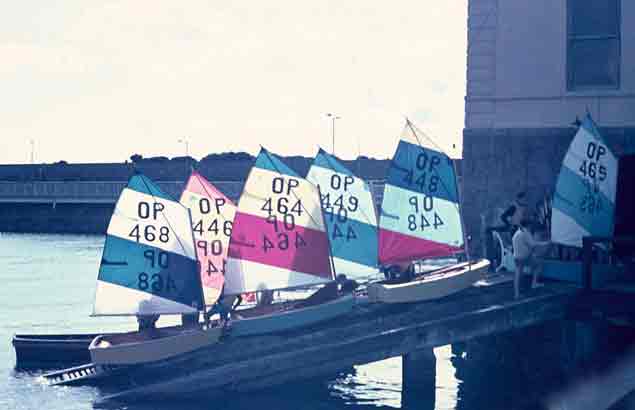 Bright morning of Optimism. The National Yacht Club slipway in 1967, long before the days of an extensive front-of-club platform, with the new dinghies of the Optimist Class being launched out of the cramped boathouse under the club, and down a steep and often very crowded slipway
Bright morning of Optimism. The National Yacht Club slipway in 1967, long before the days of an extensive front-of-club platform, with the new dinghies of the Optimist Class being launched out of the cramped boathouse under the club, and down a steep and often very crowded slipway
To grasp the significance of what is being celebrated, please try to visualize the National Yacht Club as it was fifty years ago. The building itself, standing directly in the harbour, has the air of a fishing lodge in the West of Ireland on its seaward side, and a hint of neo-classicism when seen from the town. But in the early 1960s it was very limited in its shoreside facilites for sailing dinghies. There was a boathouse entered through fine granite arches under the clubhouse itself, but to use it, masts needed to be lowered. It was served by a very steep and easily-crowded slip, while there was access to another slip on the east side of the cub which served a small area where dinghies could be stored. But while there was space for the established classes of Fireflies and some IDRA 14s, some room was also needed for the small tenders for larger yachts moored in the harbour, while the racing keelboats were served by club launches which might be substantial dinghies driven by vintage Seagull outboards.
The concept of a proper dinghy park was still only in its infancy, relatively speaking, for craft such as Dun Laoghaire’s Firefly and IDRA fleets which had been active since the late 1940s. Thus if anyone had a centreboard boat which could reasonably be expected to lie to moorings, she was obliged to do so, and the fleet of small craft lying off the club included the 17ft Mermaids and the 14ft Water Wags.
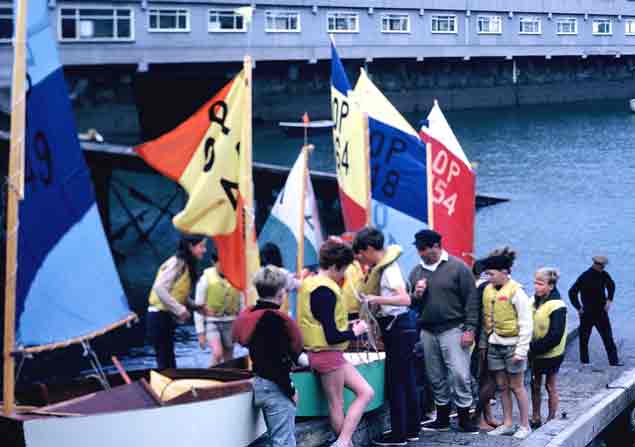 It could get very crowded on that steep slipway. Paddy Kirwan at the centre of a group making do with limited facilities
It could get very crowded on that steep slipway. Paddy Kirwan at the centre of a group making do with limited facilities
To compound the space problems afloat and ashore, during the 1960s the area in the southeast part of Dun Laoghaire Harbour off the National Yacht Club was the focal point for the cross-channel ferry berths. The railway-system serving Mailboat with its emphasis on foot passengers continued to use the Carlisle Pier to the west of the club, but the East Pier was known for a period as the Car Ferry Pier as a busy new roll-on roll-off terminal, which admittedly always had a temporary look about it, had been constructed there to accommodate the new trend in cross-channel travel.
Thus not only was anyone sailing a dinghy from shore at the National YC dong so out of decidedly limited facilities, but they immediately sailed into an area cluttered with a collection of moored boats of all shapes and sizes, and that in turn was set in an area which might have ferry ships berthed close by, or manoeuvring on either side.
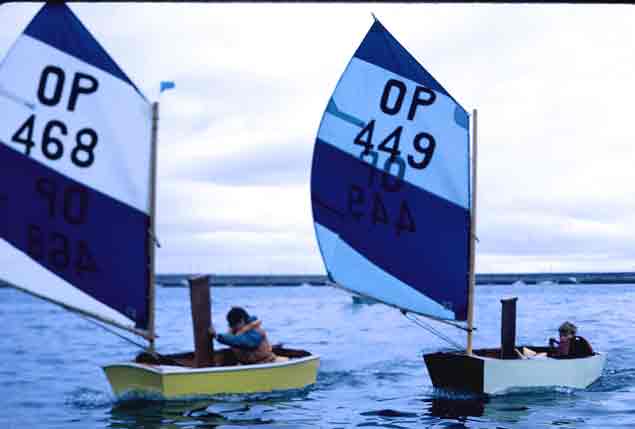 Learning curve. Gina Duffy and John Lavery on a close run in 1967. The latter has won many major championships, including the Fireball Worlds in 1995
Learning curve. Gina Duffy and John Lavery on a close run in 1967. The latter has won many major championships, including the Fireball Worlds in 1995
The comparisons with today’s National Yacht Club with its spacious platform facing out over a much clearer harbour area, and beside it an installation of convenient berthing pontoons, could not be greater. But back in the 1960s, an equally important change was happening – there was a complete re-appraisal of what the most junior sailors really needed in boats and instruction to get the best from the sport.
For sure there were the Fireflies, but in terms of lower age limit they were really aimed at adolescents on the cusp of rapidly growing youth. The other available classes were even more adult-oriented. In fact, the underlying problem was that children going sailing were treated as miniature adults who would somehow pick up the skills of the game through a sort of osmosis, whereas for a crucial period of their lives they would have most benefitted from being treated as a different species, with different boats to meet their needs.
Yet even here, adult views dominated. The grown-ups thought that young people’s boats should at least look like small yachts. Thus a dinghy which was promoted for children by several clubs was the 11ft Yachting World Cartop Heron, which had originally been conceived as a DIY-build which could fit on the roof-rack of the average family car, and was designed with a gunter rig such that all its spars could be stowed within the boat.
It had some good ideas, and with a pretty sheer it fulfilled the adult expectation of what a miniature yacht should look like. But it was surprisingly heavy for its avowed rooftop requirement – you’d have needed a weight-trained family to get it on the car roof. And anyway, it was too large for really small kids who genuinely had the sailing bug.
 The southeast corner of Dun Laoghaire Harbour was very different in 1967, with the East Pier re-designated as the Car Ferry Pier. Yet despite the limitations, the Optimist class quickly caught on after its introduction in 1967
The southeast corner of Dun Laoghaire Harbour was very different in 1967, with the East Pier re-designated as the Car Ferry Pier. Yet despite the limitations, the Optimist class quickly caught on after its introduction in 1967
So a revolutionary approach was needed, and it came thanks to one of the National YC’s international sailing stars, Johnny Hooper. He had achieved Ireland’s first Olympic Race win with Peter Gray in the Flying Dutchman in the 1960 Rome Olympics when the sailing was at Naples. But as an FD campaign towards the 1984 Olympics was prohibitively expensive with the venue in Japan, he returned to his first love of International 505 Racing, and it was at a big 505 championship in Scandinavia in 1965 or thereabouts that he first became aware of the game-changing possibilities of the Optimist for junior sailing.
Scandinavia being rightly renowned for the elegance of its yacht, it speaks volume for the versatility of the Florida-originating Optimist, the “simple little boxboat that sails surprisingly well”, that Scandinavia should lead the movement towards a world body for a boat which, whatever the traditionalists might think, the kids were clearly loving. Founded 1965, the International Optimist Dinghy Association (IODA) had Viggo Jacobsen of Denmark as its first President with his wife Edith as Secretary, and in that same year Johnny Hooper set about introducing the idea of the Optimist to Ireland.
Now if some ordinary Joe had happened to by impressed by an Optimist at some foreign location, and had even brought one home to persuade his fellow sailors that they were looking at the future, the idea probably would have fallen very flat indeed.
But that’s not the Hooper way. Instead, from his highly respected position he quietly targeted fellow National Yacht Club members who were themselves active sailors, but also had children who would benefit from the Optimist experience, and in time a group emerged which was to include initially Johnny Hooper with his wife Bernie giving the longterm involvement, Peter Gray, Paddy & Barbara Kirwan , Don Douglas, Franz & Carmel Winkelmann, Michael McGrath, Arthur Lavery and several others, many of whom had reasonable DIY skills and could see the possibility of building an Optimist in the basement of their Dun Laoghaire homes without too much disruption of the household. By the Autumn of 1966, the project was under way.
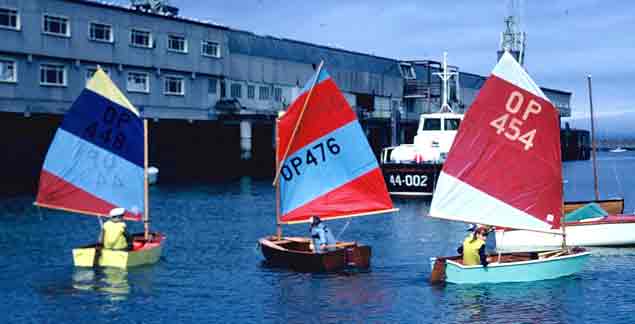 The first of the new fleet sails. Paddy Boyd (left) Ann Kirwan (centre) and Vivienne Lavery right) getting to know their boats
The first of the new fleet sails. Paddy Boyd (left) Ann Kirwan (centre) and Vivienne Lavery right) getting to know their boats
While Johnny Hooper had introduced the idea, he stood back from its continuing implementation, for the Hooper modus operandi was to give an idea enough strength to soon have wings of its own. That certainly happened in the National Yacht Club, for very quickly a manageably small committee was in being, and the formidable Carmel Winkelmann became its secretary. The NYC Junior Programme became her baby, and it always has since been seen as such, even though the number of people involved in administering the programme over the fifty years, as the NYC facilities have expanded and developed to meet the needs of a modern membership, will now run into the hundreds.
In fact, properly organized junior sailing with boats specifically designed for young people’s needs is now so central to Irish sailing that it takes a huge leap of the imagination to visualize the scene as the first small group of National Yacht Club Optimist Dinghies – most of them locally-built either by amateurs or professonals – began to emerge in May 1967 with numbers increasing as each weekend passed. New they may have been, but they reflected their era, with a public Blessing of the Boats outside the Brindley household as a new batch of boats appeared.
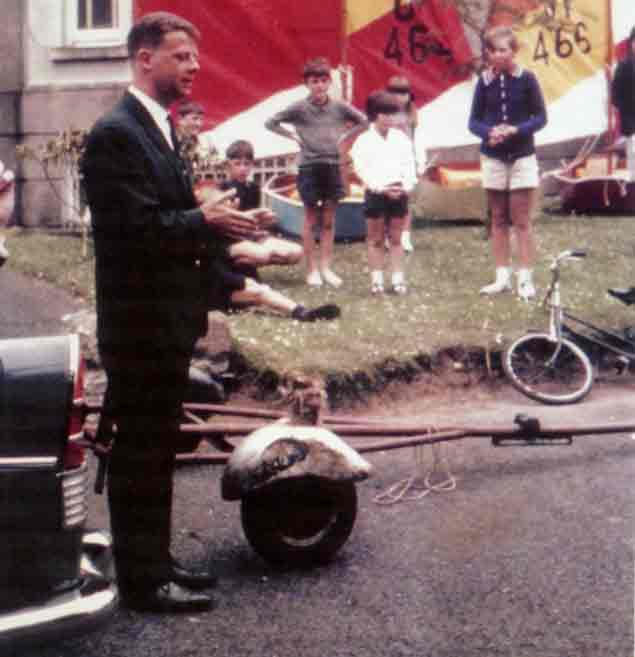 Olympic sailor Johnny Hooper speaking at the Blessing of the Boats as a new batch of home-built Optimists awaits transfer to the National’s limited space.
Olympic sailor Johnny Hooper speaking at the Blessing of the Boats as a new batch of home-built Optimists awaits transfer to the National’s limited space.
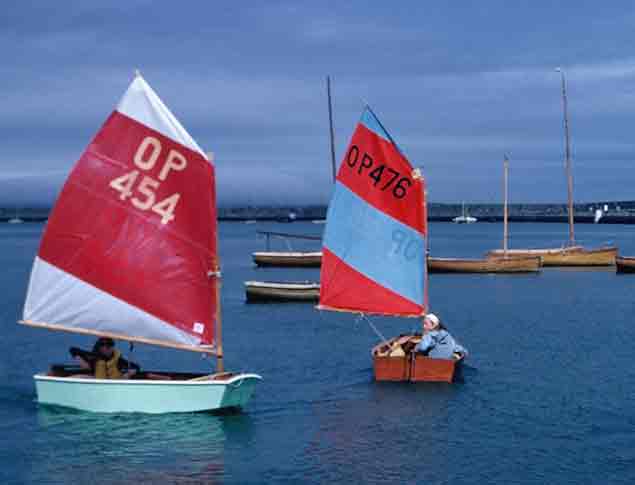 Dun Laoghaire was a different place in those days, with Water Wags and Mermaids expected to lie to mooring. Vivienne Lavery and Ann Kirwan testing their skills with the new Optimists – Ann’s boat (476) was one of the few professionally-built in the first batch of Optimists, she was created by the legendary Skee Gray
Dun Laoghaire was a different place in those days, with Water Wags and Mermaids expected to lie to mooring. Vivienne Lavery and Ann Kirwan testing their skills with the new Optimists – Ann’s boat (476) was one of the few professionally-built in the first batch of Optimists, she was created by the legendary Skee Gray
But though most young sailors in theory had his or her own boat, before anything approaching full fleet numbers was approached they’d a habit of letting anyone sail some boat or other in the early stages, so much so that although Ann Kirwan was part of it from a very early stage, she admits that even she can’t claim total accuracy when identifying the helm of a known boat.
 Going abroad......the new Dun Laoghaire Optimists make their debut at Bray Regatta: Paul, Adam and Lucy Winkelmann with Paddy Kirwan putting in his renowned act as a South American Air Marshall at Bray Sailing Club.
Going abroad......the new Dun Laoghaire Optimists make their debut at Bray Regatta: Paul, Adam and Lucy Winkelmann with Paddy Kirwan putting in his renowned act as a South American Air Marshall at Bray Sailing Club.
This habit of inter-changing sailors became even more marked in that first year when the early class discovered that the most useful base for their day-time sailing was the little-used Irish Lights service barge moored in the western part of the harbour. Over there, NYC Optimist sailors found much clearer sailing water, and they were well away from the comings and goings of the two cross-channel ferries off their home club, not to mention excessive parental control. In effect, the barge became their day-time base, and they ate their packed lunches aboard it while deciding who would take which boat for the first stage of the afternoon’s sailing. Fifty years down the line, we might well wonder if the Commissioners of Irish Lights are aware of the key role their humble barge played in launching Ireland’s Junior Training Programme.....
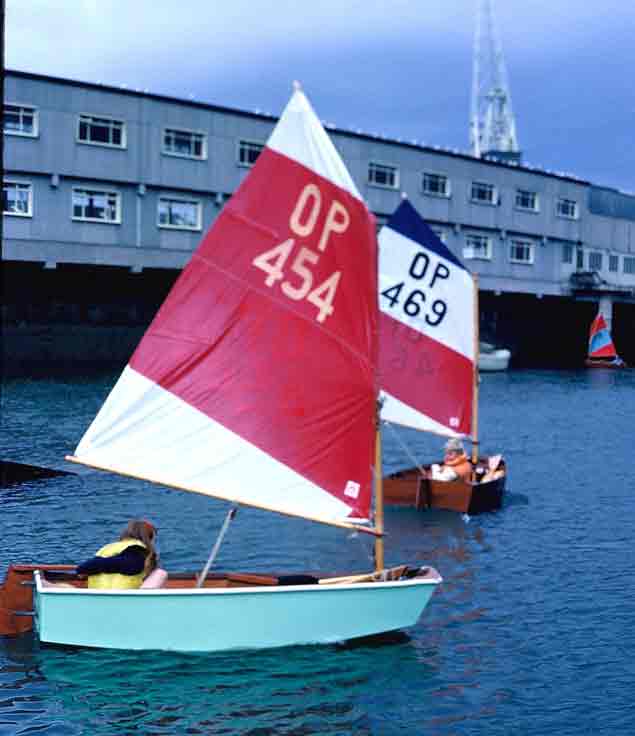 Vivienne Lavery and David Ryan getting away from the slip.
Vivienne Lavery and David Ryan getting away from the slip.
Once launched in its viable form in 1967, there was no stopping it, and the names which have emerged just from the National’s junior programme alone (for virtually all clubs now have one) take us over an extraordinary range, and up to the heights of Olympic participation, the winning of major world dinghy championships and associations with the America’s Cup.
It’s Johnny Smullen who provides the latter. The California-based Johnny Smullen in San Diego is now of world stature in anything to do with yacht and boat-building or indeed in marine construction generally, and his talent has been recognized at the highest level as he has worked on major projects for the very demanding Dennis Conner, aka Mr America’s Cup.
Johnny will have inherited his feeling for classics from his father Cass, a great sailor who was such an enthusiast for the Dublin Bay 21s in their original rather spectacular gaff-rigged form that when the class contemplated changing to a more easily-handled and convenient Bermudan rig in 1963, Cass claimed that he could easily rig a gaff-rigged DB 21 in 15 minutes flat. And that included setting the jackyard topsail to perfection. So he brought a DB 21 close into the clubhouse (as you could in those days), and in front of a drink-sipping crowd of observers on the verandah, he did the job within 15 minutes. But they still went ahead and converted to Bermudan rig.
Son Johnny meanwhile was enlisted in the NYC Junior Programme as soon as he reached he lower age limit, and when the 40th Anniversary was being celebrated back in 2007, he sent on his memoirs which well capture the flavour of it all:
San Diego, 17th May 2007
The way I saw it.
I am eight years old and my parents are wondering what to do with me for the summer, it went something like this: “Get him out from under our feet”. I was equally happy to stay at home and play in the back garden, invent stuff and dream up ways to frighten my sisters. Chasing them with worms was a good one.
I was enrolled in the adventure of my life.
At first I was lead to believe it was going to be a fun thing with the opportunity to meet new people and friends, maybe making me more sociable as I was quiet child in a world of my own. I bought into this and showed up for the first day. It was great, lots of people all different shapes and sizes, so there we were all sitting around playing with stuff and one-upping on how my father is better than yours, especially at snooker. The chatter fell silent when along came this very tall white-haired lady with an incredibly loud voice. It was at this point I became suspicious as I had just watched Paths of Glory and A Bridge Too Far, I had seen how the enemy rounded up people and put them in trucks and brought to places, unfriendly places.....
We arrived at Sandycove harbour where we were lined up on the pier. I though this was it, we were then forced to line up at the steps and walk down into the freezing water fully clothed and flail around, there were guards (instructors we were led to believe) everywhere, and just to make sure the torture was effective they made us hold our heads under water for 30 minutes, well 30 seconds, but it felt like minutes. Then we were all forced to walk back to the NYC where our fate was to be determined. Freezing and scared, I was cursing my family and wondering what I had done to them.
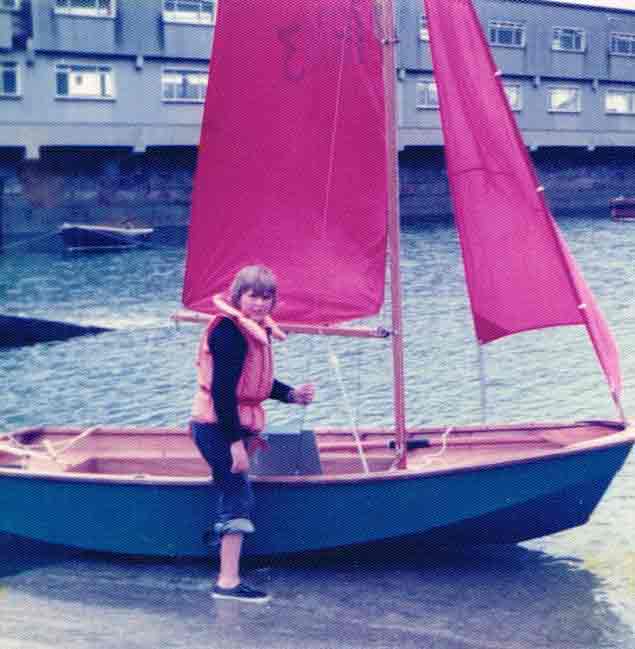 He survived.....eventually Johnny Smullen became a keen Mirror dinghy sailor, but he was pessimistic enough to call his boat Splinter
He survived.....eventually Johnny Smullen became a keen Mirror dinghy sailor, but he was pessimistic enough to call his boat Splinter
We arrived back at Camp NYC and were lined up and made to wear large cumbersome protective coats, some were yellow, purple, some orange, I guessed they were labelling us, something to do with our religion. Some of these jackets had large protective collars probably to help protect us from the beatings to come, I thought. Our names were branded onto the “Life Jackets” as I started to call them, knowing they would play a key role in our protection.
We were divided into groups and lead away by the guards into this large damp room with arches and a dank smell of cotton, hemp and mould. This was where we were to remain for all the rainy days to be brain-washed, they started by teaching us knots. I was convinced this was going to be how to tie the very knot that would be the doom of us, I compared it to carrying the cross of Calvary. I decided then to be really bad at it in the hopes that one of my knots would slip open and I could dash to my freedom. We also had to jump up, and hand-over-hand along the light blue steel beam that ran across the dark room, this was to make our arms really strong, they had a plan for strong arms – I will tell you about that a little later.
Food consisted of a march up to Wimpeys for a spice burger and chips all drowned in vinegar to disguise the taste, if there was good behaviour we got to go to the Miami Café. The day was long (except Thursdays when we had to get out early) and after a week in Boot Camp we were all tired and weary. What had I done to my family to deserve this?
The second week came along and we were introduced to the ships, rather large wooden craft resembling a landing craft with the flat bow (I was always looking for the hinges). This is where the strong arms came into. We were grouped into six per team, and the guards waited until low tide when we had to carry the ship down a rickety wooden slip (there’s a reason for calling it a slip). Upon its surface there were large wooden rollers but we were forbidden to use those rollers, and to make sure they filed a fat spot on the rollers, deeming them useless. We picked up the incredible heavy boat, all six of us, one on each corner holding a knee, and two in the middle by the oar locks. Later I was to learn the place to be was up at the bow (by the door), it was lightest. I was adapting to this cruel camp. As we descended down to the icy water again fully clothed, we came across a bright green pungent slime. I had what I thought were special sailing shoes, but as soon as I touched the slime I was down. Down hard. The guards started yelling, I knew I had to get up quickly....remember Calvary!....We reached the bottom and stopped, the guards yelled again and made us wade right into the icy deep, still fully clothed. With the landing craft now floating, we had to master manoeuvring, the craft were lined up alongside the slippy slip, that’s the reason they call it a..................
I stepped on the gunwhale. Now at this point I did not understand the physics like I do today, and when you apply a load to any point of the gunwhale of a flat-bottomed craft two things will happen (once only). The opposing gunwhale will come up as you travel down, and because I am as tall as the craft is wide, somewhere in the middle he two surfaces will meet, your face and the opposing gunwhale. After the initial shock, the second shock comes from the icy cold water. Then I found out what the large collar was for as the guards hauled me out of the abyss semi-conscious. Once inside the craft, we were grouped into two and handed oars. Let the games begin.....
After a week of rowing and shipping oars and coming alongside we were all adapting well to boating, there’s nothing to it. Just as we are enjoying ourselves, we are reminded that this is a work camp with launch and retrieval exercise twice a day. The launch and retrieval is carefully timed at 6 and 12 hours intervals to make sure it was low tide and we’d the longest slimiest walk up the rickety slips, observed closely by the guards from the window of the snooker room glaring down at us. Boating is turning out to be challenging but fun, and the new friends are all pitching together to eventually plan an assault on the guards to free ourselves.
The third week came along and there were large wooden poles with white canvas and a stick with notches cut out of it, why on earth did they have to make it harder? It was perfectly simple with the clean decks and oars and oar locks, now the boats are so heavy with this rig up, my bow lifting position is not that smart as we carry down the slip with the sail pressed hard against my face. After countless days of theory brainwashing in the damp room, we have to pass a few tests to prove worthy to sail, if called upon, out to the US Aircraft Carrier John F Kennedy anchored out in Dublin Bay. The first test was to take the stick with the notches and stretch out the canvas and hook onto a rope loop, without falling over this was harder than carrying the feckin’ boat, the second was to line up two pins while hanging over the transom full of chips and spice burgers. If it had hair....
Most of us mastered that task after a few tries, and it wasn’t long before we were sailing out to the sterns of the ferry Hibernia or Cambria, whichever was in port at the time. This went on for a few weeks and as we settled into the routine it got easier as we went on.
During the time in the damp boathouse, usually when it was blowing dogs off chains outside and while I was trying to get the batteries out of the loudhailer, I noticed a beautiful varnished clinker planked boat, it was almost new, and a very wise man was looking after it. This Man was tough as the rivets holding it together and knew everything about the seas. I knew if I paid attention he would help get me through the summer, he did and he is almost responsible for what I do today. Thank you Jack!
The discipline of Boot Camp had turned us into great sailors, great card players, snooker players....it wasn’t until the third stage we found flagons. But not on the night of May 17th 1975, I was at home doing my homework that night....
Ah.....the memories, I hope I have stirred a few, it was the most wonderful time of my life and I wish I was there to get drunk with all of you and play cards till the wee hours, but meanwhile thanks
To Carmel, thank you very much; I always have my lifejacket.
To Jack Brennan, I am always thinking of you up there, and thanks for teaching me how to tie my shoelaces.
To all the instructors Paul, Ann, Jimmy, I never believed the story of the rabbit and the tree, but thanks anyway
And to all my dear family and friends
Lots of love, Johnny Smullen
PS It was me that stuck the coke bottle in the cannon at the front of the club....
 Johnny Smullen and Dennis Conner inspect the hull of the 1925-built Cotton Blossom
Johnny Smullen and Dennis Conner inspect the hull of the 1925-built Cotton Blossom
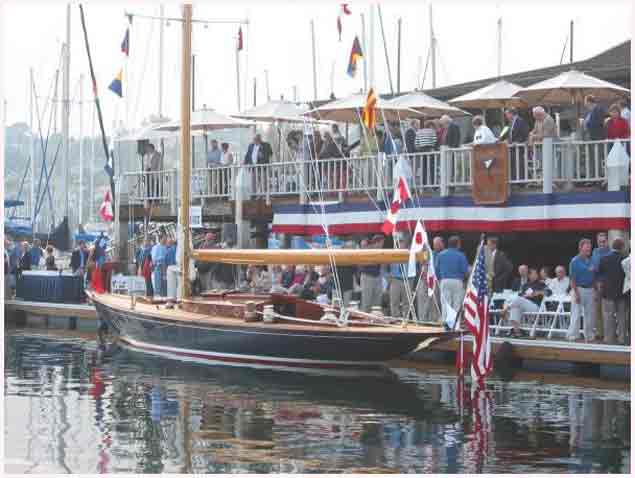 Cotton Blossom II after restoration by Johnny Smullen
Cotton Blossom II after restoration by Johnny Smullen
Inspired by Jack Brennan and other master craftsmen, Johnny has gone on to become a shipwright of such skill from his base in San Diego, California, that he in turn inspires others, one of his most famous projects being the complete restoration of the 49ft Q Class sloop Cotton Blossom II of 1925 vintage.
When a complete restoration is contemplated, Johnny doesn’t mess about. The word is that when he and Dennis turned up to finalise the deal on Cotton Blossom and bring her back to San Diego, they found the previous owners sorry enough to see her go, and rather proud of the style in which they’d maintained her. But after they’d gone to sort the details with the new owner, they went to take a last look at the boat. It’s said they found that Johnny had already delivered his opinion on the existing rig by cutting the shrouds and stays at the deck with bolt-croppers, and cutting the old mast off at deck level with a chainsaw.
Maybe that’s an apocryphal Johnny Smullen from taking delivery of another boat. Yet when you see Cotton Blossom in her restored form, it’s clear what Johnny says should indeed be Holy Writ. This is a project of world standard. But what’s even more remarkable is that despite everything the Sailing Boot Camp at the NYC might have inflicted on him all those year ago, Johnny’s love of boats and sailing is such that he has his own personal sweet classic, the lovely 36ft International One Design Altair. She’s sailed as often as possible, and though he can’t make it back to Dun Laoghaire next month for the Golden Jubilee as there’s very major project under way, Altair will be racing with the San Diego classics under the National Yacht Club burgee.
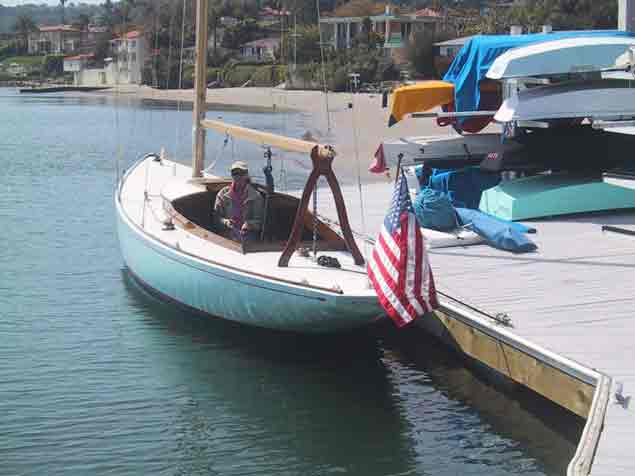 Johnny Smullen’s own pet boat Altair reveals his abiding love of sailing.
Johnny Smullen’s own pet boat Altair reveals his abiding love of sailing.
John Lavery’s father Arthur was another of those pioneering Optimist dads back in the late 1960s, and John and his sister Vivienne were both in that first batch of trainee sailors. He ended up winning championships in more classes then you could quickly count, but the peak of it all came in September 1995 when he and David O’Brien of this parish won the Fireball Worlds in Dublin Bay.
In fact, the graduates from 50 years of a junior training programme at the National YC can be found in successful positions in many boat classes in many places, but it is the club’s outgoing attitude to those who wish to learn to sail which deservedly provided its most outstanding success. A long time ago a Mrs MacAleavey, a widow with no sailing connections, was looking for a club which would make her increasingly boat-mad daughter Cathy – who had recently bought a clapped-out 420 – feel encouraged in any way to learn to sail. Despite the fact that it was still in process of recovering from a fire in the clubhouse, the NYC showed itself the most welcoming along the Dun Laoghaire waterfront, so much so that Mrs McAleavey felt sufficiently encouraged to buy her daughter a new 420, and that in turn led on eventually to Cathy representing Ireland in the women’s 470 in the 1988 Olympics.
The three children she had with husband Con Murphy went on to get their introduction to sailing through the National YC’s junior programme, and daughter Annalise emerged with the talent and the burning ambition which resulted in a heart-breaking fourth at the 2012 Olympics in the Women’s Laser Radial when a medal had seemid almost certainly within her grasp. But memories of that were entirely laid to rest with the Silver Medal in the 2016 Olympics Rio after a difficult final race in which the lone sailor seemed to stay as cool as you please, while the nation at home watched with bated breath.
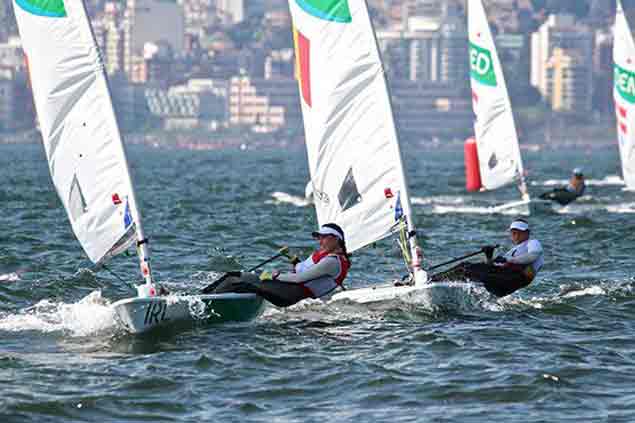 The medal-winning moment as Annalise Murphy crosses the finish line in Rio to win Silver.
The medal-winning moment as Annalise Murphy crosses the finish line in Rio to win Silver.
That it was ultimately a very personal achievement is something respected by her club, and they claim to have done nothing more than provide the first steps on the pathway, and a general spirit of encouragement. But nevertheless the success is all of a piece with the Golden Jubilee which will be celebrated on May 20th, and Carmel Winkelmann continues in her mission of providing a background of training for young sailors of all types, whether they aim only to be a competitive club sailor, or whether they aim for the ultimate heights.
Thus one of her projects in recent years was to find real support for young Finn Lynch, who had reached that difficult stage of being a top junior sailor, yet still had to find his feet as an adult. Thanks to support raised by Carmel, he became Ireland’s representative in the Men’s Lasers at Rio despite going through the final stages of the selection with a training injury recovery problem which may have had an adverse effect on his performance in as the youngest sailor in Rio, aged just 20.
Whether or not he would have been better off not being in Rio at all is neither here nor there. When you’re 20, four years can seem an appallingly long time. The Tokyo Olympics in 2020 must have seeemed aeons away for a young sailor who had shown many flashes of real talent. It was better for him to be in Rio while learning a lot, rather than kicking his heels in frustration in some dead end. And when he needed material help to see through the campaign, it was Carmel Winkelmann who was there to make to ensure that support was available. That will be something else for celebration on May 20th.
 Carmel Winkelmann and Finn Lynch at the National Yacht Club, June 2016. Photo W M Nixon
Carmel Winkelmann and Finn Lynch at the National Yacht Club, June 2016. Photo W M Nixon
Dun Laoghaire Regatta Casts Net To Celebrate Kingstown Bicentenary
There could well be as many opinions as to what constitutes a true classic or traditional boat as there are owners of these often highly individual craft. As part of the celebration of the Bicentenary of Dun Laoghaire Harbour – where the first stone was officially laid by the Viceroy on 31st May 1817 - the organisers of the Volvo Dun Laoghaire Regatta 2017 (it’s from July 6th to 9th) will be including a Classics, Traditional and Old Gaffer section. This will, in addition to putting extra emphasis on older classes already regularly involved such as the Glens, the Mermaids, the Howth 17s, the IDRA 14s and the Water Wags, be extending a welcome to older boats of other types, and to classic classes from Ireland and around the Irish Sea. W M Nixon reports on progress in this special feature of a very attractive new dimension to Ireland’s biggest sailing event.
If you want anything done in introducing a new twist to sailing, make Cathy MacAleavey the organiser of the special sub-committee in charge of moving things along. And if you want to be sure things are going in the right direction as regards classics and traditional craft, make sure that that Hal Sisk is being consulted and will be personally involved in one or maybe all of his classic craft, for the contribution he has made to the appreciation of our boat heritage in Ireland is unmatched.
Former Olympic sailor and round Ireland record holder Cathy is now herself very much a mover and shaker in the classics, as she has built a Water Wag and a Shannon One Design working alongside the great Jimmy Furey of Leecarrow in Roscommon, and races regularly in both classes.
On being appointed to this completely new post last Autumn by top honcho Tim Goodbody, Chair of the overall Organising Committee, one of the first things she remembered was that while taking part in the Glandore Classics some years ago, she’d been much taken with the Fife One Designs from the Menai Straits, little gems some 24ft 6ins LOA whose design origins go back to 1926, and have been thriving as a class since the 1930s.
 The Royal Anglesey Fifes racing in the Menai Straits. Although the class was first designed in 1926, and gained full strength early in the 1930s, this will be their first visit to Dun Laoghaire. Photo: Ian bradley
The Royal Anglesey Fifes racing in the Menai Straits. Although the class was first designed in 1926, and gained full strength early in the 1930s, this will be their first visit to Dun Laoghaire. Photo: Ian bradley
These days they hunt as a pack and many of them are well organised for road trailing, so on the assumption that they would be heading to the Glandore Classics 2017 on July 23rd, she sent an email to class chairman Richard Tudor suggesting that they might like to take in Dun Laoghaire on the way. It turns out that they won’t be at Glandore in late July as they’re expected to take part in the four yearly Celtic Festival in the Menai Straits at much the same time. But their diary was reasonably clear for the 6th to 9th of July and the Dun Laoghaire festivities, and they’re coming to race for the new Kingstown Cup big time.
This is doubly interesting, for they’re very much a William Fife design and only six inches shorter than the Alfred Mylne-designed Glens, yet the two comparable classes have never raced in the same event. Needless to say the chances of an inter-fleet race in Dun Laoghaire is now high on the agenda.
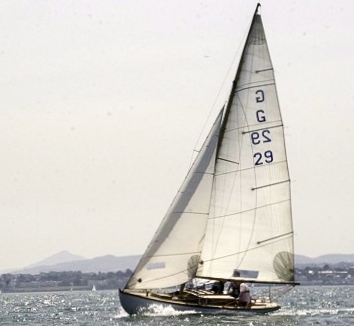 An Alfred Mylne-designed Glen Class OD on her home waters of Dublin Bay in the kind of conditions everyone hopes for in July 2017.
An Alfred Mylne-designed Glen Class OD on her home waters of Dublin Bay in the kind of conditions everyone hopes for in July 2017.
 The Glen class neatly demonstrate their need for traditional moorings in their allocated area off the Royal St George YC
The Glen class neatly demonstrate their need for traditional moorings in their allocated area off the Royal St George YC
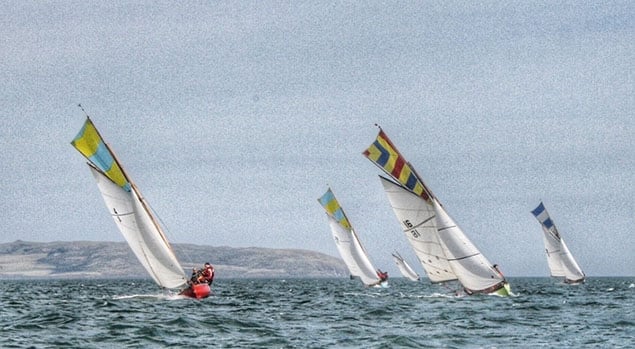 The 1898 Howth 17s will be coming in force from Howth, but they’ve adapted the programme to suit their needs, with a race from Howth to Dun Laoghaire on the Friday, a full day’s racing on the Saturday, a morning race on the Sunday, and then a race home after the prize-giving ceremony.
The 1898 Howth 17s will be coming in force from Howth, but they’ve adapted the programme to suit their needs, with a race from Howth to Dun Laoghaire on the Friday, a full day’s racing on the Saturday, a morning race on the Sunday, and then a race home after the prize-giving ceremony.
So at a stroke, Cathy had given wings to the new event. But at the same time she was casting a fly over Hal Sisk, against whom she regularly races in the Water Wags, but who had his 1894 Watson-designed, Hilditch-built 36ft classic gaff cutter Peggy Bawn on the market, as more than ten years have elapsed since his team completed the wellnigh perfect restoration of this boat in 2005.
Peggy Bawn had been based in Dun Laoghaire Harbour continuously since 1919, and then after her restoration, she became a much-admired feature in classic regattas on both sides of the Atlantic. To say that Hal Sisk has done his duty by her is under-stating the case, yet when Cathy approached him about making Peggy Bawn the centrepiece of the VDLR Classics Regatta, he said he’d already decided to do so, and was looking forward to it very much.
 Peggy Bawn in her newly-restored form in 2005. Anyone contemplating a similar project should spend hours studying this image……Photo W M Nixon
Peggy Bawn in her newly-restored form in 2005. Anyone contemplating a similar project should spend hours studying this image……Photo W M Nixon
While all this was going on in the background, one of the members of Cathy’s sub-committee, Guy Kilroy, was constructing a database of all the classic and traditional classes within Ireland or within reasonable reach. Although most of them are very location-specific and few have the trailers for a long road journey, you just never know who might be swept up in the general enthusiasm for an event which is really beginning to buzz, and certainly the exotic Shannon One Designs will be turning up in strength.
Meanwhile, there’s the mysterious territory which is the Old Gaffer’s Association, which came into being in 1963 when people realised there wasn’t any organisation looking after the needs of boats which weren’t really classics in the strictest sense, yet fitted into so many other categories that they almost defied definition.
Ironically, the OGA was founded in the very year that Dublin Bay’s perfect exemplars of the gaff-rigged racing cutter, the Dublin Bay 21s, changed over to Bermudan rig. Yet as the 2013 Golden Jubilee Round Britain and Ireland cruise of the OGA showed, the Old Gaffers thrive as never before. And as it happened, in 2015 and 2016 the President of the overall Old Gaffers Association was Dun Laoghaire’s own Sean Walsh, owner-skipper of the very gaff-rigged Heard 28 Tir na nOg.
But Sean was due to stand down as President in London in January 14th 2017 – last weekend, in other words. Fortunately, there was just time to convene a meeting of key people before that happened, and a gathering in the NYC of Sean Walsh, Dublin Bay OGA President Denis Aylmer, Ian Malcolm of the Howth Seventeen and Water Wag classes, and Cathy MacAleavey and her husband Con Murphy, did a lot to improve mutual understanding and clarify the in-port needs of Old Gaffers, which are different from those of Classics, which are in turn very different from those of easily-manoeuvred modern craft with auxiliary engines.
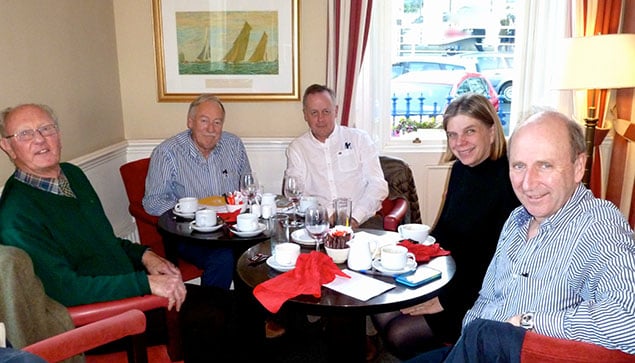
Even before Sean and his team had left for London for the OGA changeover, the word had come through from Paul Keogh, skipper of the Clondalkin community-owned-and-built full-size Galway Hooker Naomh Cronan, that he and his crew would be delighted to take part in Dun Laoghaire in July.
This was another key decision, for the Naomh Cronan is now the only full-sized traditional Galway type on the Irish Sea. But while the great hooker voyager Paddy Barry now sails the seas in a 45ft Frers-designed cutter, it was also confirmed that he too would be taking part, as crew aboard Sean Walsh’s Tir n nOg.
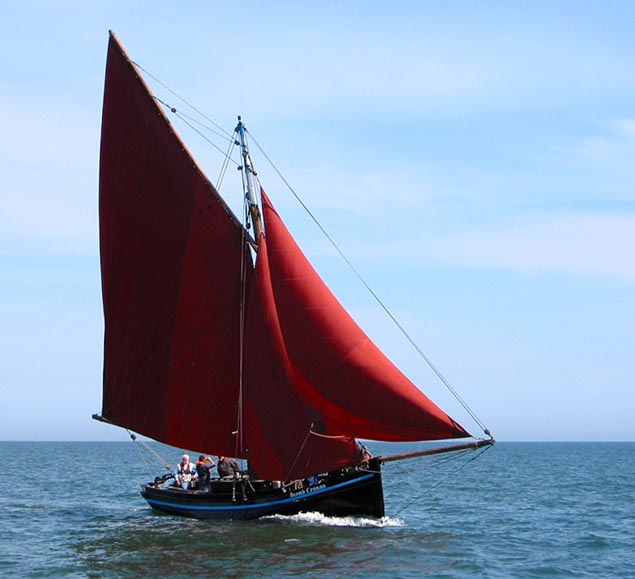 The Clondalkin community-built Galway Hooker Naomh Cronan. Her commitment to the Dun Laoghaire Traditional regatta has greatly encouraged the organisers. Photo: W M Nixon
The Clondalkin community-built Galway Hooker Naomh Cronan. Her commitment to the Dun Laoghaire Traditional regatta has greatly encouraged the organisers. Photo: W M Nixon
 Sean Walsh’s Heard 28 Tir n nOg in racing mode. In Dun Laoghaire in July 2017, his crew will include legendary Galway hooker voyager Paddy Barry. Photo: Dave Owens
Sean Walsh’s Heard 28 Tir n nOg in racing mode. In Dun Laoghaire in July 2017, his crew will include legendary Galway hooker voyager Paddy Barry. Photo: Dave Owens
So the main building blocks of a great event are now going into place, and it’s a matter of building on this sound foundation. With the organisers fully aware of the need to provide proper liaison officers for each special group or class, the need for designated berthing between the Carlisle Pier and the East Pier is also being addressed, as it is the most suitable space, and has the bonus of providing the best possible public view of some of the most interesting-looking boats around.
Thus invitations are on their way to the likes of Scott and Ruth Metcalfe with their characterful schooner Vilma on the Menai Straits, and Mike Clark with his traditional Manx nobby White Heather at Peel in the Isle of Man.
 The Menai Straits-based schooner Vilma (Scott & Ruth Metcalf) is exactly the kind of vessel the Dun Laoghaire event is aimed at. Photo: W M Nixon
The Menai Straits-based schooner Vilma (Scott & Ruth Metcalf) is exactly the kind of vessel the Dun Laoghaire event is aimed at. Photo: W M Nixon
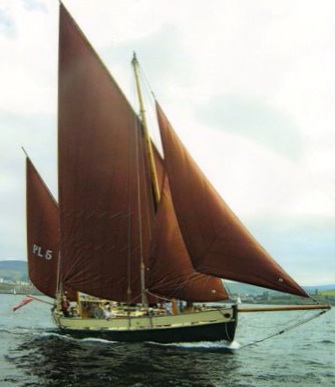 Mike Clark’s Manx Nobby White Heather
Mike Clark’s Manx Nobby White Heather
At the other end of the Isle of Man is Joe Pennington with his restored Manx longliner Master Frank, an asset to any regatta, while across in Strangford Lough Dickie Gomes may have his 1912-built 36ft Kearney yawl Ainmara on the market after 51 years of ownership, but if she doesn’t move he says he is on for Dun Laoghaire.
For several years. Ainmara was Dun Laoghaire-based, but the Dun Laoghaire class which everyone would most particularly welcome back would be the Dublin Bay 24s which raced in the bay from 1947 to 2004. Here’s a rough-cut vid from their final race in the bay in 2004, since then they’ve been taken to Brittany in hope of restoration, but only one has had the complete job done. Originally called Periwinkle, she is now re-named Grace, and is based at Douarnenez, but if she could be persuaded back to Dublin Bay for July 2017, who knows what doors might be opened.
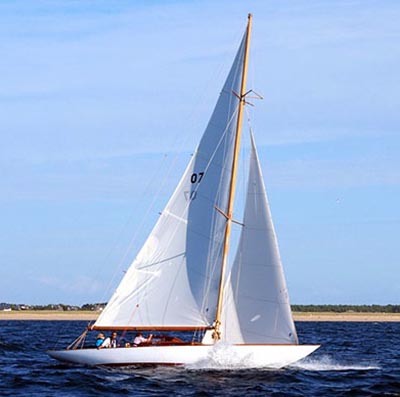 The restored Dublin Bay 24 Grace (ex-Periwinkle) is now reported to be based in Douarnenenz, but she would be very welcome back in Dublin Bay
The restored Dublin Bay 24 Grace (ex-Periwinkle) is now reported to be based in Douarnenenz, but she would be very welcome back in Dublin Bay
Boats of a very different kind came centre stage many years ago in another Hal Sisk initiative, the Bantry Boats built to the design of the ship’s longboat left behind in Bantry after the unsuccessful French invasion of 1796. From the new involvement came the Atlantic Challenge, and you’ll find Bantry Boats at many ports, though there are few enough of them in Ireland. But the Dun Laoghaire festivities would provide an ideal opportunity for them, as the final day of the regatta, Sunday 9th July, is also being pencilled in for a full-on traditional rowing competition for the East Coast Skiffs.
 The Pembrokeshire Bantry Boat sailing off the coast of southwest Wales. Some racing for these very special craft is another proposal for the Dun Laoghaire regatta
The Pembrokeshire Bantry Boat sailing off the coast of southwest Wales. Some racing for these very special craft is another proposal for the Dun Laoghaire regatta
In fact, with so much effort being made to provide proper waterfront facilities in Dun Laoghaire, it’s a case of the more the merrier, and another interesting vessel whose management have indicated positive interest is the Conor O’Brien ketch Ilen, currently nearing completion of her restoration through the Ilen Boat Building School of Limerick at Liam Hegarty’s boatyard at Oldcourt near Baltimore.
Ilen is due to be launched in April and will be in full commission by July. The very fact of having a complete suit of new sails will make her look better than she ever has since she was built in 1927, and if she does turn up to Dun Laoghaire welcome, it will be a very different boat from the tired-looking vessel at the end of her working days in the Falkands, the vessel which was finally, thanks to Gary MacMahon’s initiative, returned to Ireland in 1998.
In other words, so many ideas are flying around about the fresh shapes and new vitality that the Kingstown Bicentenary can add to the Volvo Dun Laoghaire Regatta that all things are possible.
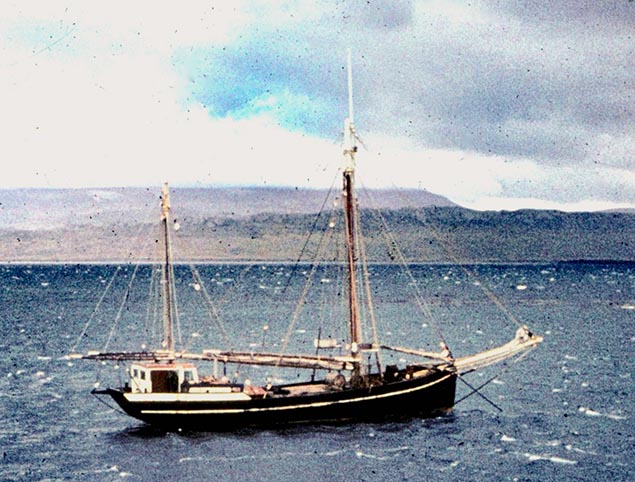 The Conor O’Brien ketch Ilen towards the end of her working days in the Falkland Islands. In fully restored form, she is expected to launch in April of this year, and may well include the Volvo Dun Laoghaire Regatta in her 2017 programme. Photo courtesy Ilen Boatbuilding School
The Conor O’Brien ketch Ilen towards the end of her working days in the Falkland Islands. In fully restored form, she is expected to launch in April of this year, and may well include the Volvo Dun Laoghaire Regatta in her 2017 programme. Photo courtesy Ilen Boatbuilding School
See New IDRA 14 ‘Wicked Sadie’ On RTÉ’s Nationwide Tonight
#OnTV - Clontarf’s new-build classic wooden dinghy Wicked Sadie will feature on RTÉ One’s Nationwide programme this evening at 7pm.
Nationwide’s team spent two days filming ‘Number 166’ and the build crew, both on the water and off, before her official maiden sailing.
The IDRA 14 was launched this past June after a three-year-long project by the Clontarf Yacht & Boat Club team, as previously reported on Afloat.ie.
“Wicked Sadie couldn't have come into existence without the physical and moral support of so many,” said the build crew in a statement, as they encouraged supporters to tune in and “see the results of all of your hard work and incredible support”.
Watch Nationwide this evening (Wednesday 26 October) at 7pm on RTÉ One to see the sneak peek of Wicked Sadie as she readied for launch.
But not to worry if you miss it as the programme will be available later for catch-up on RTÉ Player for the next 30 days.
IDRA 14s 70th Anniversary Dinner at Royal St. George YC This Saturday
The 70th Anniversary of the IDRA 14ft OD dinghy class has been marked in spectacular style throughout the 2016 season writes W M Nixon, with the latest newly-built classic clinker boat (no 166) being launched in June, a well-supported and hard-raced Annual Championship at Lough Derg Yacht Club at Dromineer in August, and a two day celebration afloat and ashore at one of the class’s spiritual homes, Clontarf Yacht & Boat Club, in September. This convivial event was well attended by IDRA 14 sailors past and present - some from very far back – together with a boat and support team from the IDRA 14’s sister class, the Dragonfly OD at Waldringfield Sailing Club in Suffolk. Read Afloat.ie's review here.
However, in the final analysis it’s arguable that the genesis of the class was born within the Royal St George Yacht Club in Dun Laoghaire from the productive minds of Billy and Jimmy Money, together with Douglas Heard.
Douglas Heard was later RStGYC Commodore in addition to being founding President of the Irish Dinghy Racing Association, owner of IDRA 14 Number 1, and winner of the first Helmsman’s Championship in 1947. So all the logic pointed to rounding out the 70th Anniversary Season with a Gala Dinner this Saturday (October 15th) in the Royal St George Yacht Club, and although it’s already well-booked, we’re told there are still some places left which will be of interest to the hundreds of people who have been involved with this remarkable class at some time during the past 70th year.
One of these is Irish Sailing Association President David Lovegrove who raced IDRA No 107 Spray at Sutton Dinghy Club during the 1960s, and he and his wife Kate will be mingling with fellow enthusiasts who will all be talking clinker nine to the dozen on Saturday night. If you’re comfortable with the technology you can make your dinner bookings on line through the RStGYC website, if any queries please ring Ian Sargent at 087 6791069 or Suzanne McGarry at 087 2425331.
Those already booked for the dinner are bringing along IDRA 14 memorabilia including photos going back seventy years, and if you happen to have something in that line yourself you’ll be doubly welcome.
Irish Sailing Finds Its Soul In Clontarf & The IDRA 14 Dinghy
A two-day celebration in a coastal suburb of Dublin to mark the 70th birthday of a 14ft One-Design sailing dinghy class may not seem an event of major significance in an island nation which can trace its recreational sailing history back for 300 years and more. Yet in becoming involved at Clontarf Yacht & Boat Club in the IDRA 14 Class’s honouring of its three-score-years-and-ten last Sunday, W M Nixon found he was getting a special insight into what makes us tick both as a sailing community, and as part of Irish society as a whole.
Clontarf is a place which is comfortable with itself. It’s not Dublin’s poshest suburb. It doesn’t want to be. It just wants to be itself - an unassuming pleasantly leafy place with a south-facing waterfront, a place which is convenient to the city yet clearly has a healthy identity of its own. And Clontarf is quietly confident that, in its combination with its many and various clubs, organizations, and societies, it possesses a higher level of social capital than other smoother suburbs where the social structures might seem more glossy, but genuine depth of community may be lacking.
Clontarf Yacht & Boat Club is typical of this. For sailors from elsewhere, its setup at first seems challenging. For starters, you can only get sailing for half of the time. In the other half, the tide is out. They’ll tell you this has the benefit of providing alternative time for the local cricket and rugby clubs. Yet despite the apparent tidal inconvenience, every year there seem to be more boats on the drying moorings than ever before. And when the tide comes in, they really do go sailing, unlike other non-tidal clubs, where the continuous availability of sailing makes people more picky in choosing their weather.
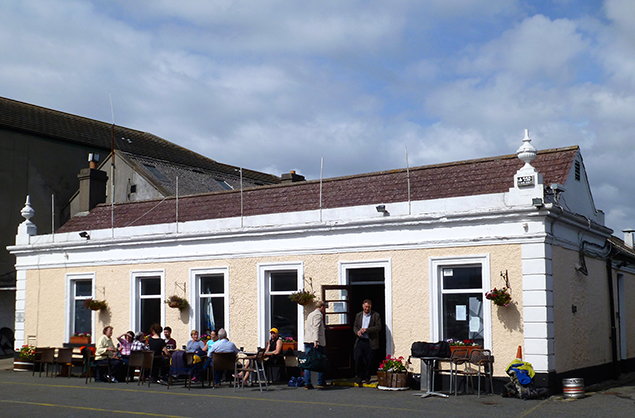
Another Clontarf factor which strangers find difficult is the existence of a busy road through the club’s dinghy park. Or at least it goes straight across the short distance from the dinghy park to the slipway. It’s something which the founders hadn’t planned. When Clontarf Yacht & Boat Club was set up in 1875, it established its HQ in a charming little shoreside farmhouse called Belvedere which was not only pleasantly south-facing, but had an uninterrupted and unrivalled view to the Dublin and Wicklow Mountains across the inner waters of Dublin Bay.
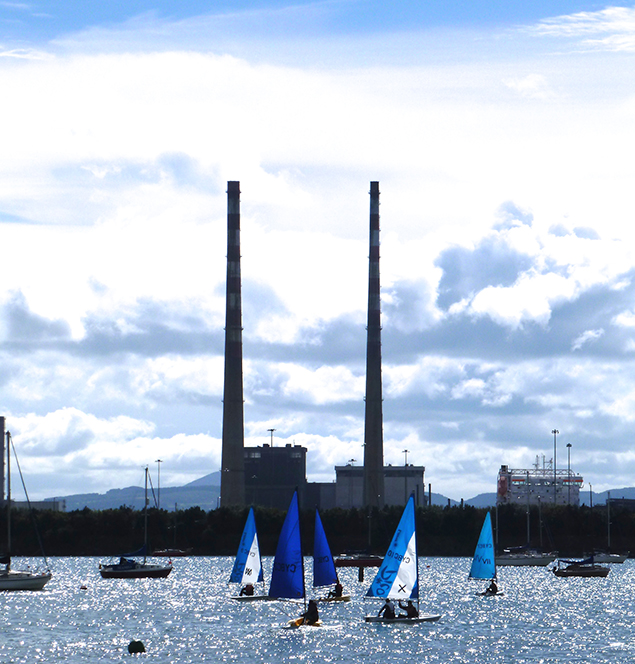 Clontarf Y & BC’s formerly clear view to the Wicklow Mountains is now somewhat interrupted, but the junior squad can still get in their training session afloat before the IDRA 14 fleet takes over the sailing water. Photo: W M Nixon
Clontarf Y & BC’s formerly clear view to the Wicklow Mountains is now somewhat interrupted, but the junior squad can still get in their training session afloat before the IDRA 14 fleet takes over the sailing water. Photo: W M Nixon
Over the years the clubhouse acquired some embellishments to become more pavilion-like, and what had been little more than a coastal path in front of it became almost roadlike as the built waterfront extended eastward. But thanks to the enormous presence of Lord Ardilaun’s St Anne’s Park estate further along the shore at Dollymount, the main road out to Howth continued to be the old post road going well inland through Raheny.
However, inevitably in time the James Larkin Road was created along the shore at Dollymount to provide a more direct main road to Howth, with traffic increasing year on year until now it seems to rumble by in a continuous stream between Belvedere and the sea.
In the circumstances, any club which wasn’t such an integral part of its community might well have considered re-location. But Clontarf Yacht & Boat Club is very much local and community-based, and it has adapted instead, even becoming accustomed to the fact that much of its once flawless view across the bay to the hills and mountains is now interrupted by the expansion of Dublin Port, with the latest addition to the intermediate skyline being the monumental new incinerator rapidly taking shape across in Ringsend.
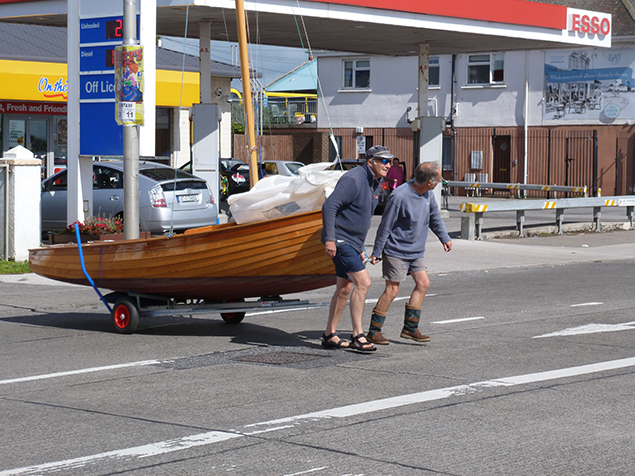
Yet if it’s a half decent sailing day, and the tide is flooding, Clontarf leaps to sailing life. On Sunday afternoon when the good weather mercifully lasted much longer than predicted, the place was buzzing not only with good-humoured aficionados of the IDRA 14 Class celebrating their boat’s 70th birthday, but with a host of trainee juniors who got in their sailing session before the fine fleet of historic IDRA 14s took over the stage for their concluding review of the fleet parked in line along the green, in readiness for launching and rounding out the celebrations with a Parade of Sail afloat mostly close along the waterfront, something which was most easily organized simply by making it a race.
Throughout it all, Sunday walkers and locals of every speed and type moved along Clontarf’s fine promenade mingling with the boats and boat people and everyone – whether sailors or not – seemed to know everyone else, or at least felt they did, while the multiple presence of cheerful dogs of all shapes and sizes improved things even further.

As to the business of getting your boat out of the dinghy park and across that busy road to the slipway, former Clontarf Y & BC Commodore Ian Sargent demonstrated the technique to perfection: “You just step out slowly, you’ll find the traffic starts to slow down, then as they see what’s going on they’ll come to a stop if need be as you walk across in confident but unhurried style. Then as you get safely across, it is absolutely imperative that you wave your thanks to all involved”.
It was primarily thanks to Ian Sargent and his tolerant wife Rebecca that last weekend’s celebrations took place. He is the total IDRA 14 nut, lovingly researching and recording the history of every boat back to that immediately post-war time of precious hope, but little else, in 1946. Back then, far-sighted people like Douglas Heard and Billy & Jimmy Mooney in Dun Laoghaire in November 1945 set in train the movement which became the Irish Dinghy Racing Association, and in so doing they reached out to other clubs nationwide in mutual support with fellow-enthusiasts.
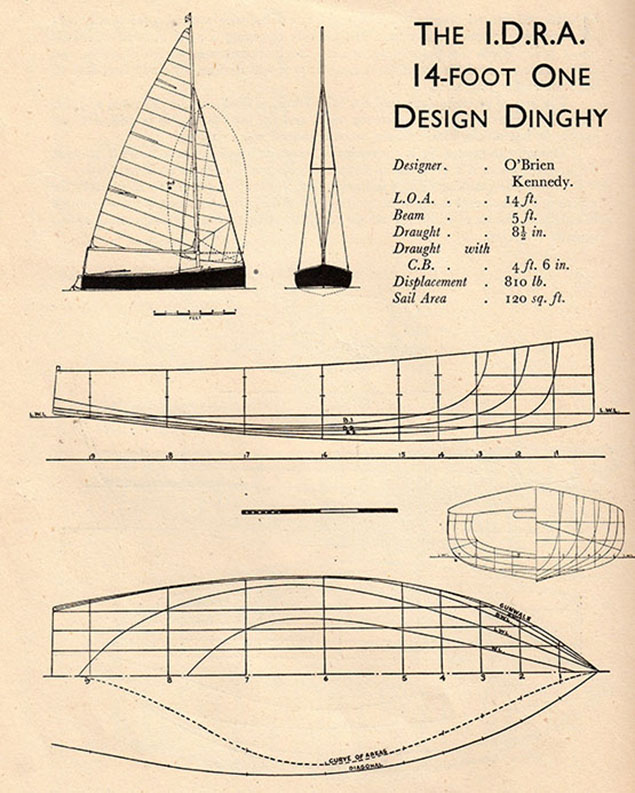 The IDRA 14 as first publicised in 1946. Within weeks, 46 boats were under construction by bot professionals and amateurs.
The IDRA 14 as first publicised in 1946. Within weeks, 46 boats were under construction by bot professionals and amateurs.
The flagship of the new Association became the IDRA 14, developed from a design by an Irish naval architect working in England, George O’Brien Kennedy. His period of working across the water was later fondly recalled by fellow yacht designer David Thomas, who used to say that Brian – as everyone knew him – would come up with more innovative boat ideas in a morning than the rest of the office produced all week.
Admittedly some of his ideas were frankly crazy. But in developing the design of the clinker–built IDRA 14 from a boat he’d designed for his own use in 1938 but whose possible expansion as a class was stymied by World War II in 1939, he produced an eminently sensible design which not only suited Irish needs at the time, but was also later successfully used in slightly modified form at three English sailing centres.
One of the clubs which immediately embraced the new Irish boats with huge enthusiasm was Clontarf Yacht & Boat Club, and it has remained such a stronghold of the class that the very newest IDRA 14, Wicked Sadie number 166, was timber built in classic style in a shed out the back of the club by a team co-ordinated by Rowan Melling, a two year project which reached it successful conclusion to considerable acclaim with Sadie’s Gala Launching at Clontarf on June 25th 2016.
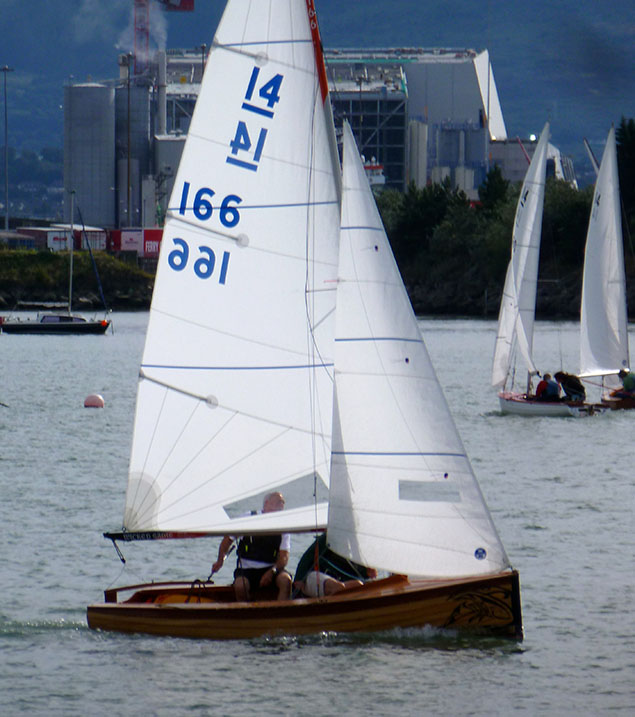 They’re both the newest things in town. The IDRA 14 Wicked Sadie was first launched on June 25th 2016, and beyond her is the newest part of the national infrastructure, the Ringsend Incinerator. Photo: W M NixonThe very first boats were built nearby in 1946, just across the Tolka Estuary from Clontarf in Jem Kearney’s boatyard at Dublin’s East Wall. A brother of the noted yacht designer and builder John Kearney, Jem was something of a rough diamond, but those who worked with him or learned something of the skills from his boat-building classes thought very highly of him and his work.
They’re both the newest things in town. The IDRA 14 Wicked Sadie was first launched on June 25th 2016, and beyond her is the newest part of the national infrastructure, the Ringsend Incinerator. Photo: W M NixonThe very first boats were built nearby in 1946, just across the Tolka Estuary from Clontarf in Jem Kearney’s boatyard at Dublin’s East Wall. A brother of the noted yacht designer and builder John Kearney, Jem was something of a rough diamond, but those who worked with him or learned something of the skills from his boat-building classes thought very highly of him and his work.
There isn’t the space here to detail the way the early sail numbers were allocated, as 46 boats were soon in various levels of construction – both by professionals and amateurs - from an early stage, and each club group which had signed up to the new class was given a batch of numbers with the boats getting afloat in random order.
Thus the first boat in commission was actually Number 14, Deirdre built by Jem Kearney for that renowned sailing cleric, the Reverend George Good, whose exuberant approach to life suggested that he might have felt much more at home in one of the livelier periods of the 18th Century. As to Deirdre, she almost immediately became a mystery which still hasn’t been explained to this day. All we really know is that in due course George God appeared with another new IDRA 14, but this time built by Walter Levinge of Athlone, yet still sporting sail Number 14 and still called Deirdre.
Meanwhile other boats were appearing in much more orthodox style in rapid succession, with Number 1 being built by Kearney for Douglas Heard himself, though quite why he called her Error we can only guess. But whatever the reason, she won the first championship in 1947, and she’s still gong strong and was at the Clontarf celebrations in the proud ownership of Jim Lambkin of Sutton Dinghy Club.

Next in line numerically at Clontarf on Sunday was a boat which has more than a few connections with this parish, but we’ll come to that anon. No 4 Dusk was another 1946-built Jem Kearney boat whose first owner was Hugh Allen, who went on to crew for Alf Delany in the Swallow Two-Man class in the 1948 Olympics, sailing in the first-ever Irish Olympic Sailing Team.
In return, Alf Delany then crewed for Hugh in Dusk in the 1949 IDRA Championships at Crosshaven at what was then the Royal Munster, and they won overall. This staging of an event at Crosshaven was a great boost to the class’s development in Cork, and the local firm DBL – Driscoll, Bushe & Leonard, with George Bushe and Dick Leonard the main partners – became much involved with their construction.
But Cork owners were as canny then as they are now, and in 1950 Crosshaven sailing brothers Barry and Harold Cudmore ordered a new IDRA 14 from George Bushe on condition that he’d won the nationals with her. George was as good a helmsman as he was a boatbuilder, so he cheerfully took up the challenge, built the boat, signed up the legendary Kevin O’Regan as crew (see Afloat obit) and off they went to the 1950 Nationals at Dromineer. And they duly won, which left the Cudmore brothers with boat now called Monaveen, and a very high standard of performance to maintain.
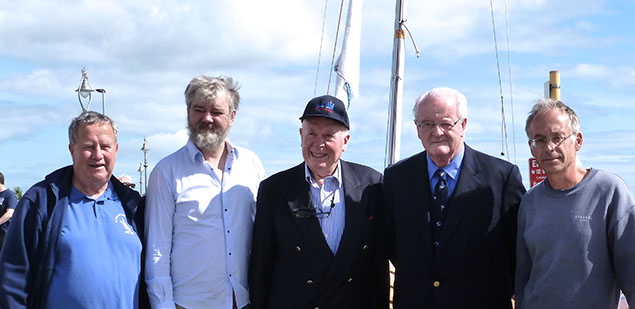
Histories of Ireland in the late 1940s and on through the 1950s paint the picture of a nation in total economic stagnation, yet the IDRA 14 class so captured the Irish sailing imagination that these became the class’s special years, good times which extended on into the early 1960s, for in 1960 the class had up-graded itself by permitting synthetic sails and adding a trapeze for zippier performance in a breeze.
The list of sailors who got involved with the IDRA 14s in these boom years reads like a Who’s Who of top Irish sailors, as people of the calibre of Douglas Heard, Jimmy Mooney, Hugh Allen, Jem Sullivan, Charlie Sargent and Peter Odlum were to be joined by the Cudmore clan, Denis Doyle, Conor Doyle, Joe Fitzgerald, Mick Sullivan, Ted Crosbie, Ian Morrison, Liam McGonagle, Desmond Keatinge, Bunny Conn, Roy Dickson, Dougie Deane, Jackie O’Reilly, Johnny Vaughan, Sid Shine, Philip Jacob, John Millar, John Godkin, Sean Flood, Clayton Love Jnr. and many others.
Crosshaven’s own Clayton Love Jnr’s involvement was undertaken with typical thoroughness, as he’d had George Bushe build him Miss Betty (IDRA 14 no 54) in 1949 with all those special skills which George Bushe could bring to a winning boat which was also a work of art. Then Clayton gave the IDRA 14 Class six years of his enthusiastic attention, winning just about everything with the Cork fleet, and taking the national title twice, in 1953 at Crosshaven, and 1955 at Dunmore East, crewed by Donal McClement in ’53 and Hugh Barry in ’55.
He then sold the boat on to Sean Flood of Clontarf, who in turn won the Nationals with her at Wexford in 1958 and Ballyholme in 1959. But by this time what had been Ireland’s premier dinghy class for a dozen years was beginning to feel the pinch as newer designs came forward, and several of the top IDRA 14 people moved into the exotic realms of the International 505 Class, which in Ireland became a sort of moveable feat, an elite group of upwards of a dozen top dinghy talents who might deign to take part in the annual IDRA Dinghy Week, but equally they might descend with their own road show on select places such as Dromineer on Lough Derg, where their activities afloat and ashore became the stuff of legend.
But while the exotic heights of the 505 class were all very well for those who could afford it, the solid citizens of the IDRA 14 class were determined to keep their much-loved boats as a viable racing option at both club and national level, and during the 1960s the contribution of the Sargent family to the class’s continuing health was remarkable.
The patriarch of the clan, Charlie Sargent, was general manager of timber merchants T & C Martin, so there were few people in Dublin who knew more about wood. But in his spare time, he was also a boat builder whose skills were way beyond those of many professionals, and near the family home firstly in Clontarf, and later in Sutton, he produced masterpieces of the boatwright’s art and craft.

He’d been involved with the IDRA 14s as both builder and owner since 1946, but it was in 1962 in Sutton, working with his son Gerry, that he built what many would reckon to be his masterpiece, no 38 Starfish. With her combination of clear spruce planks and a beautiful mahogany sheerstrake, for appearance Starfish has become the definitive IDRA 14 by which other boats are rated. And she soon proved herself a winner too – in 1963 Gerry Sargent, crewed by his brother Ian, won the Nationals at Skerries with her.
By this time the class had to face off another challenge, the increasing popularity of glassfibre construction for new dinghy classes, and here too the Sargent family played a key role in moving things forward. Much and all as Charlie Sargent loved building boats in classic style in wood, the class eventually persuaded him that they desperately needed a fibreglass hull option if they were to continue moving forward. Having accepted this, Charlie Sargent gave it his full support, and he built the plug for the mould for the new GRP hulls which were made by Delcraft of Malahide.
Then he and his family finished the bare hull with the deck and other wood trim to have her racing under Ian Sargent’s command as Sea Urchin 3 (later Swift, no 114) in the 1977 season, and by 1979 they had the GRP boats up to speed, with Ian winning the championship at Lough Ree.
The continuing health of the class then found another option in 1993 when the restored Dusk (no 4) was one of the star exhibits at the Dublin Boat Show. She’d been mouldering since 1978, but was brought back to classic life by Tom O’Brien and his son David, editor of Afloat Magazine, in a project with WEST System agents Waller & Wickham which showed that epoxy saturation techniques worked very well in restoring vintage IDRA 14s. A number of specialist firms were involved in the Dusk project, with Alistair Duffin of Belfast (best known as the top International GP 14 builder) installing the deck, centreplate casing and the thwarts in the bare hull as finished by the O’Briens, while Wicklow Marine Services were in charge of the final stages.
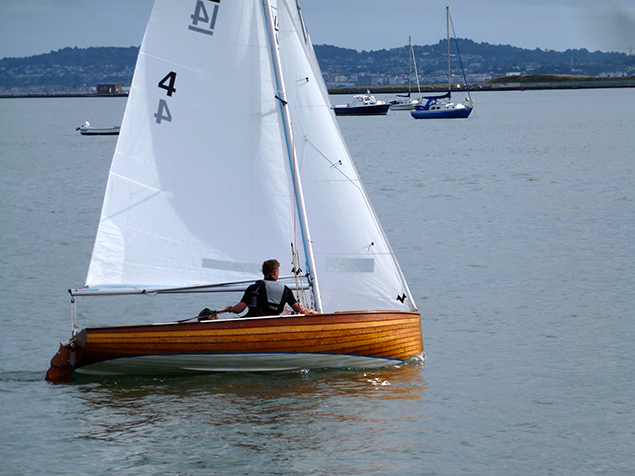 Originally built for Olympic sailor Hugh Allen in 1946, Dusk was restored in 1993 by Tom and David O’Brien in a demonstration of the potential of the WEST method. She placed second in Sunday’s 70th anniversary race. Photo: W M Nixon
Originally built for Olympic sailor Hugh Allen in 1946, Dusk was restored in 1993 by Tom and David O’Brien in a demonstration of the potential of the WEST method. She placed second in Sunday’s 70th anniversary race. Photo: W M Nixon
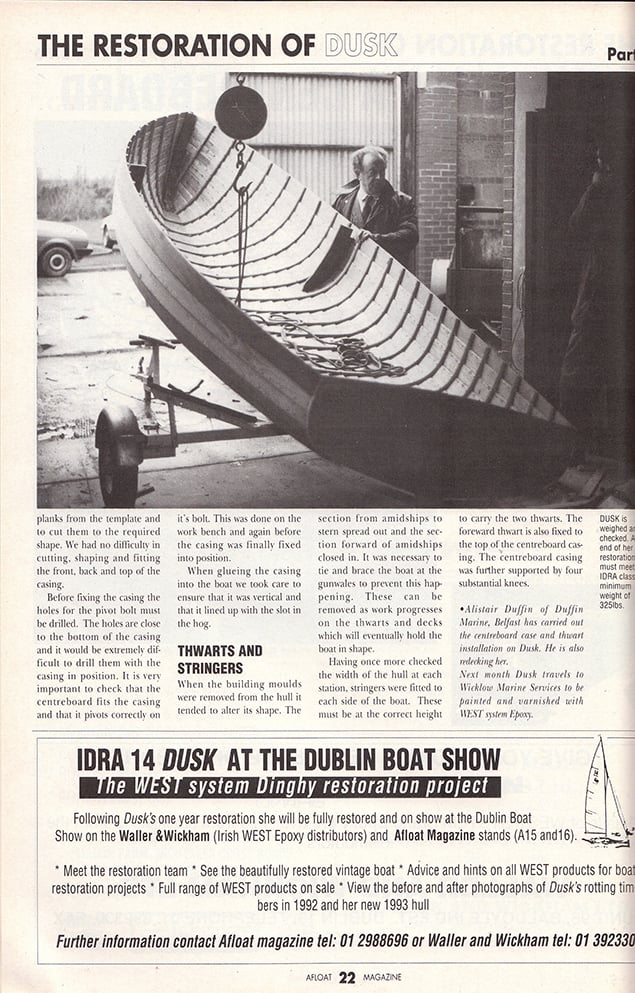 "A page from Afloat Magazine for January-February 1993, the photo showing Tom O’Brien with the restored bare hull of Dusk being weighed as part of the stringent measurement rules of the IDRA 14 Class and below a cutting from the April 1993 issue shows Dusk did indeed make it for the Dublin Boat Show in March
"A page from Afloat Magazine for January-February 1993, the photo showing Tom O’Brien with the restored bare hull of Dusk being weighed as part of the stringent measurement rules of the IDRA 14 Class and below a cutting from the April 1993 issue shows Dusk did indeed make it for the Dublin Boat Show in March

David O’Brien had a successful year racing Dusk, taking the runner-up slot in the Nationals in 1993 at Carlingford to the evergreen Starfish (Terry Harvey, Sutton). Subsequently he moved into Fireballs with John Lavery with such success that by 1995 they were World Champions, but Terry Harvey went on to reap continuing success with Starfish in the IDRA 14s, with more championship wins than anyone else.
However, others have got in on the act, and the milestone of a first woman champion was reached by Scorie Walls of Sutton racing Chance (no 163) at Galway Bay in 2000, and she retained the title the following year at Lough Ree racing Starfish. As for the first all-female crew to take the title, that came in 2012 on Lough Erne when Julie Ascoop of Clontarf crewed by Heather Keenan won in Chaos.
The rich texture of the class’s history over the years has always been something to celebrate, and it was very special when O’Brien Kennedy himself turned up to be the Guest of Honour at the Golden Jubilee in 1996. The golden thread of the storyline in Ireland has been further reinforced by developing contacts with the sole remaining class of sister-ships, the Dragonflies at Waldringfield in Suffolk in the east of England on the lovely River Deben.

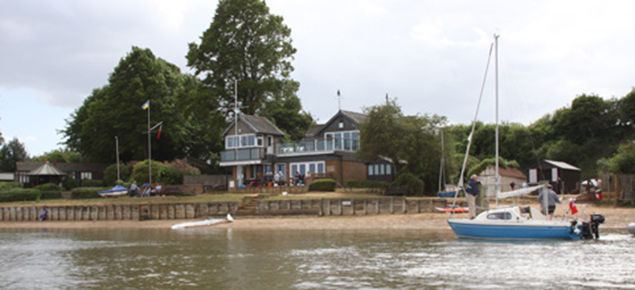
The Dragonflies were founded in 1949, so when their 70th birthday comes along in 2019, a strong contingent of IDRA 14 sailors will be descending on Waldringfield and doubtless putting much business the way of the famous Maybush Inn as well as the bar of Waldringfield SC. But meanwhile the news from Suffolk was that classic boat enthusiast James Palmer, a former engineer but now born-again traditional boatbuilder, had just built the newest Dragonfly in classic style, so Ian Sargent set to work persuading him and ten of his fellow club members to come to Ireland for last weekend’s party at Clontarf, bringing the new boat Phoenix with them. It all came together in time, and there we were last Sunday in sunny Clontarf with upwards of thirty IDRA 14s of all vintages lined up along the promenande, with the new Wicked Sadie and the new Phoenix in pride of place, when the magic ingredient was added.
Clayton Love Jnr, IDRA 14 Champion in 1953 and 1955, and Sean Flood, IDRA Champion in 1958 and 1959, turned up to wish everyone well and inspect the fleet and then see the Parade of Sail, which already had all the makings of a good race.
But we’d to wait a while for it, for it seems that once you’re an IDRA 14 man you’re always an IDRA 14 man, regardless of the many famous boats with which you’ve been subsequently associated. So the two legends of the class’s history took their time in inspecting the fleet, having a particularly long chat with Jim Lambkin with Error, the boat with which Douglas Heard won the first championship in 1947.
The links with the past were then completed with the arrival of Shane O’Brien Kennedy, son of the late designer, who was soon fitted up with a berth for a race in which the Dragonfly visitors from Waldringfield were also spread through the fleet.
James Palmer himself raced Phoenix in what seemed at first a slightly unfair match, as the Waldringfield class have adhered strictly the their original 1949 specification, including wooden spars and traditionally-shaped sails, whereas the IDRA 14s have long since been into alloy spars with a rig as souped-up as it can be, with most of the top boats now setting sails made by Dick Batt, though it was very evident that Wicked Sadie has preferred North.
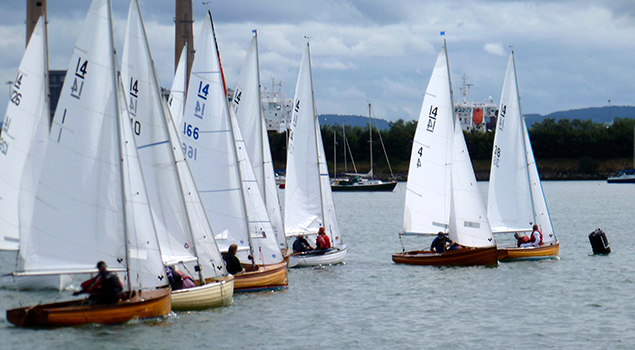 Seconds to go to the start….Gerry Sargent in Starfish (38) is exactly where he wants to be, and so too is Neil Cawthorn with Dusk (4). Photo: W M Nixon
Seconds to go to the start….Gerry Sargent in Starfish (38) is exactly where he wants to be, and so too is Neil Cawthorn with Dusk (4). Photo: W M Nixon
But handsome is as handsome does, and there was no avoiding the imperatives of history. Shaping up for the start, Gerry Sargent sailing Starfish with Ian McCormick as crew was right there on the pin to keep himself on the left hand side of the first beat. Neil Cawthorn of Waldringfield with Andy Sargent on Dusk nipped past his stern on port but clear across the rest of the fleet still on starboard.
Most of them were keen to get onto port as soon as possible for the traditional win move along the Clontarf wall in the very last of the flood, with no lack of useful advice from helpful promenadeers within yards of them. But out on the left was the place to be, and Gerry Sargent scrunched Starfish up to the mid-river line of breeze at every opportunity, sailing in clear wind when fleet numbers meant that few other boats always had clean air, and Starfish had a fine lead from Dusk at the first mark.
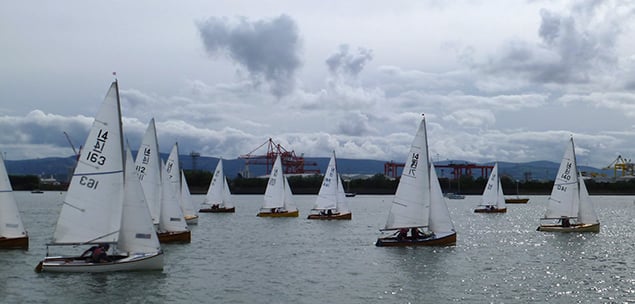
The wind lightened in the two long reaches to take in the south mark, and by the time the leaders were approaching the lee turn down toward the Royal Dublin Golf Club, the ebb had started as Gerry Sargent came round the mark with an enormous lead, and still next in line, and now equally clear of the boats behind, was Dusk, while in the midst of the tail-enders was Phoenix, feeling very far from home in the green fields of Suffolk.
But once the ebb starts running at Clontarf, it doesn’t hang about. It fairly sluices along the promenade and over the Clontarf slip, swirling towards the North Bull Wall. Yet having been so far ahead, Starfish had much less of this adverse tide, which only increased her enormous lead and she was able to work along the shore using the slightly better breeze there nearing the finish, as too was Dusk, though by now quite some time later.
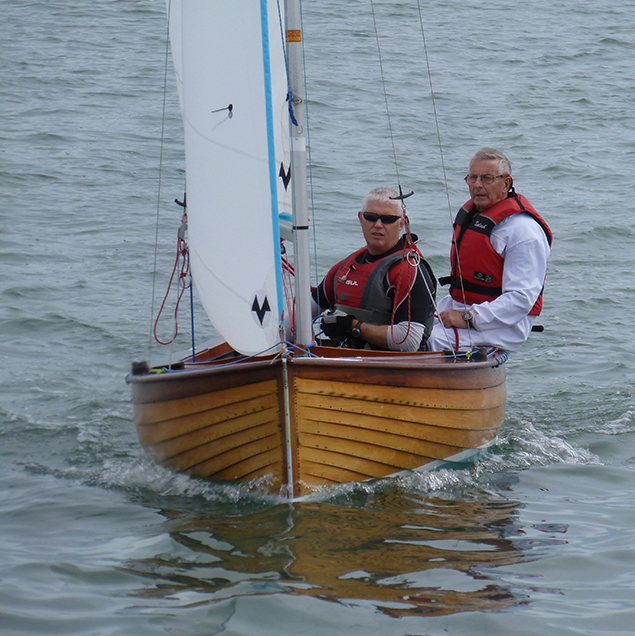
But the rest of the fleet were getting in each other’s way hoping to find an eddy right inshore east of the slip. It was their undoing. James Palmer sensibly kept himself clear of this melee, and sought the new breeze out towards the middle. It paid off big time. Phoenix went from crab grass to contender in that final beat, and finished sixth with dozens of supposedly hotter boats well behind her.
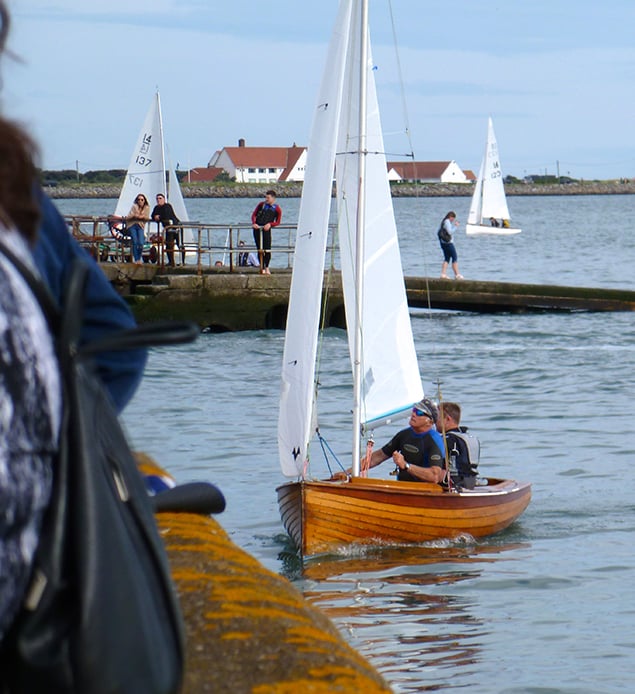 Promenade racing. Dusk closing in on second place, with the Royal Dublin Golf Club in the background. Photo: W M Nixon
Promenade racing. Dusk closing in on second place, with the Royal Dublin Golf Club in the background. Photo: W M Nixon

It was a fairytale ending to a magic day. The winner was the most beautiful boat in the class, sailed by a man who built this most beautiful boat with his father 54 years ago. Second place was filled by the boat which won the championship in 1949, a boat which, in this year of Irish Olympic sailing medals, gives us a direct link back to that very first Irish Olympic team of 1948. She is also the boat which, in 1993 in another father-and-son project, showed what can be done to keep a classic IDRA 14 in good order through the newest techniques. And in a very honourable sixth place, there was a visitor who had come a long distance in many ways in order to join the IDRA 14 class in celebrating their 70th birthday.
It was a day to remember and cherish, so here’s the list of the top six: 1st Starfish (1962, sailed by Gerry Sargent); 2nd Dusk (1946, sailed by Neil Cawthorn); 3rd Siobhan (1979, sailed by Louise McKenna); 4th Delos 2 (1953, sailed by Derek Jacobs); 5th Slipstream (1978, sailed by David Rowland), 6th Phoenix (Dragonfly, 2016, sailed by James Palmer).
And if you’re minded to absorb further the special nature of the IDRA 14 Class, this video below from the 1950s which Lough Derg YC presented to the class when they held their 2016 Nationals down there three weeks ago, the winners being Alan Henry and Simon Revill from Sutton.




























